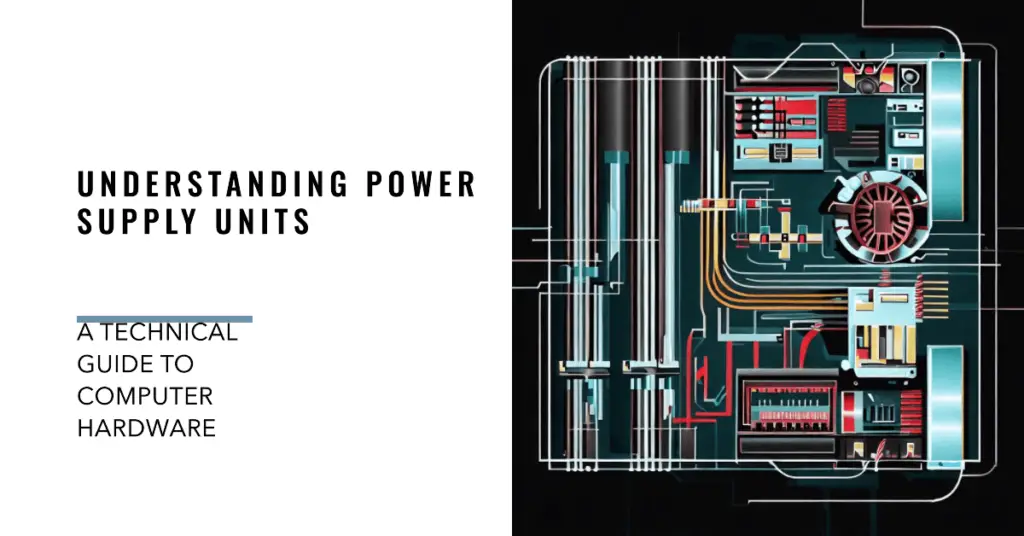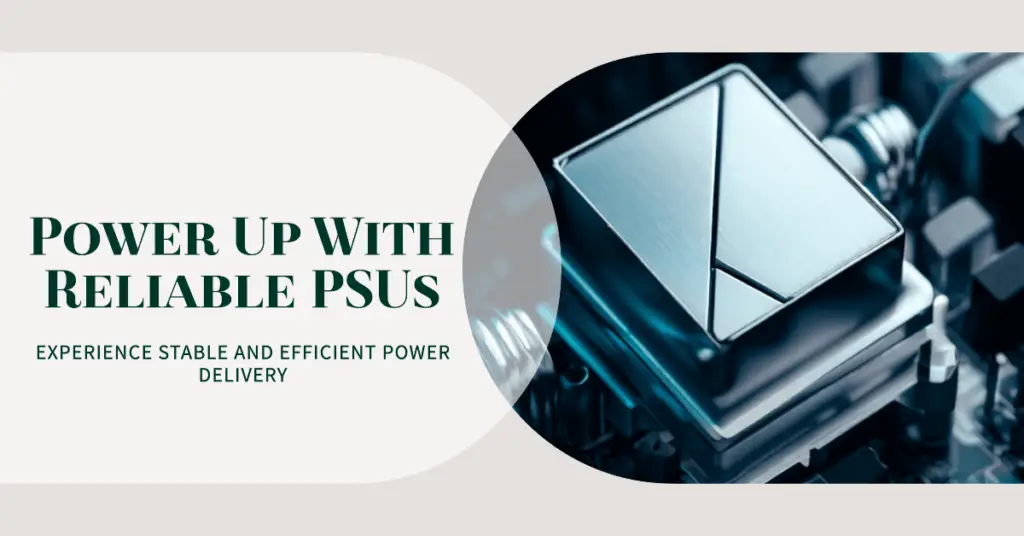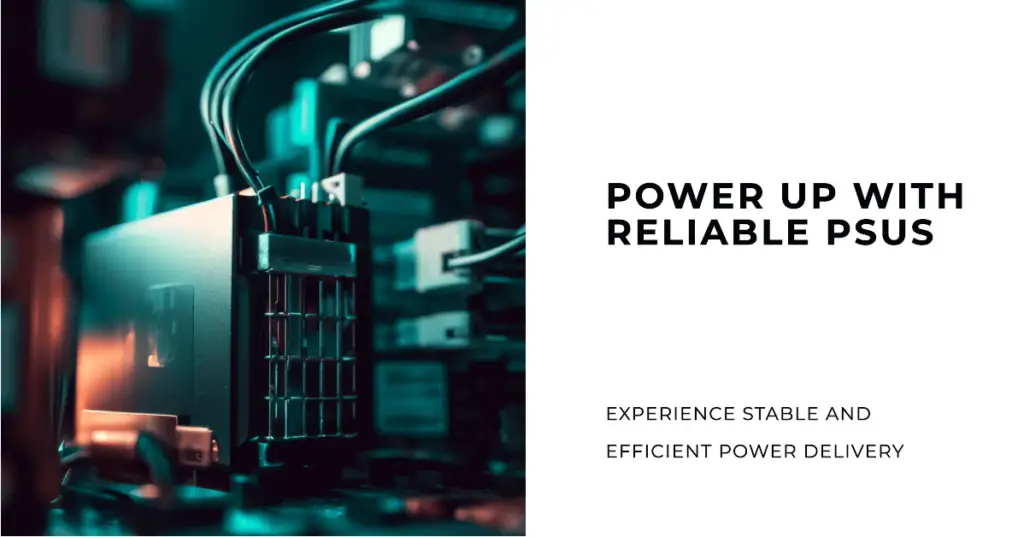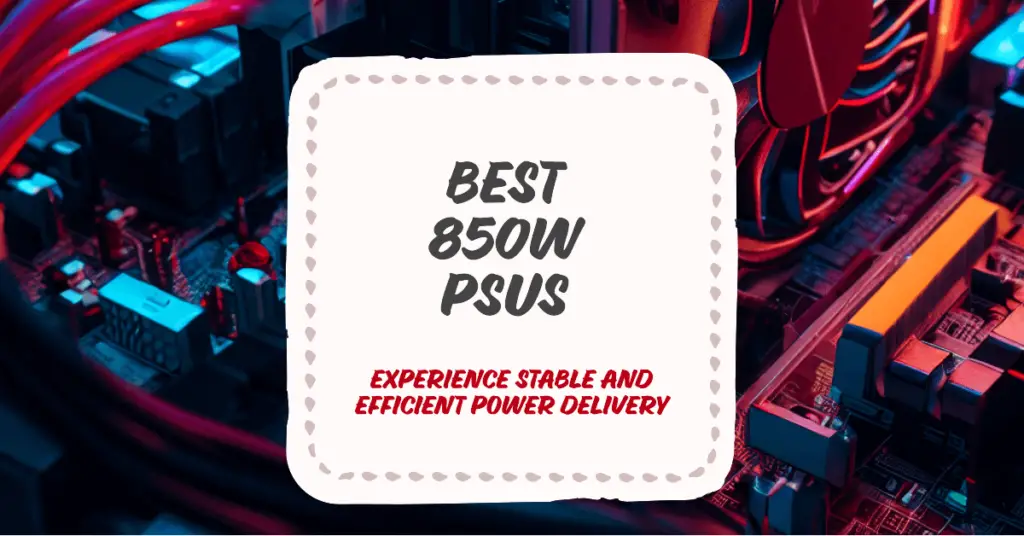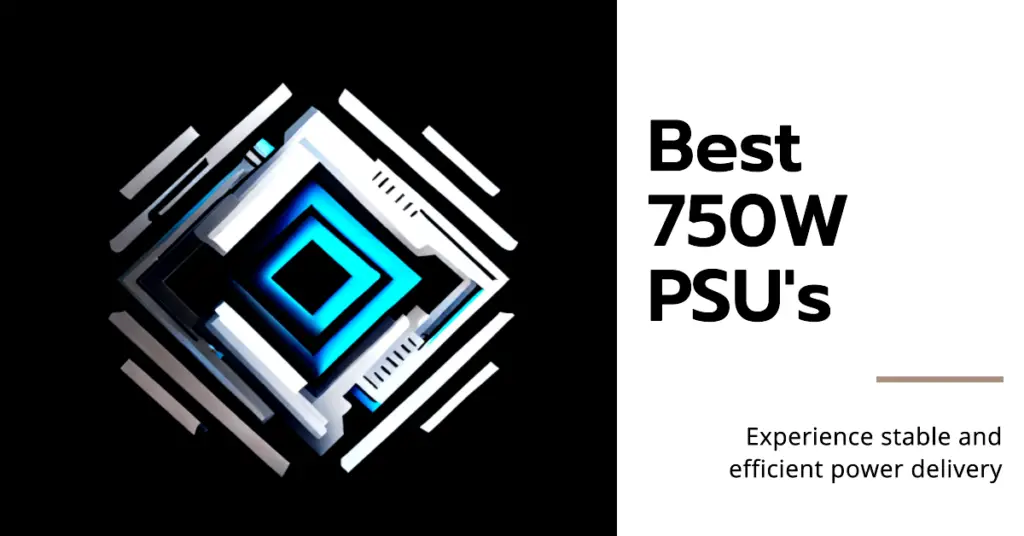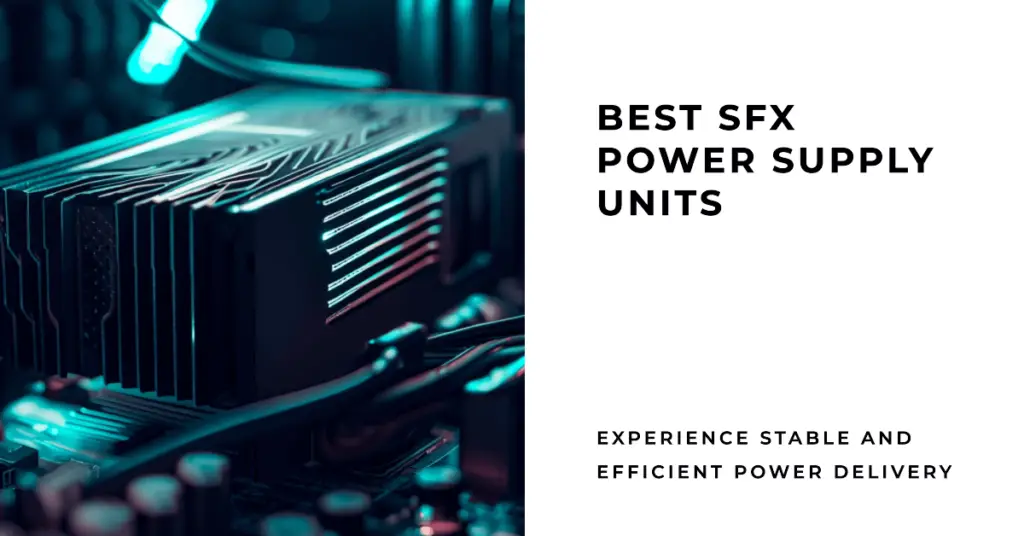In computer building and upgrades, the Power Supply Unit (PSU) often gets overshadowed by more exciting components like processors, graphics cards, and SSDs.
However, choosing the right PSU is critical. An unreliable or insufficient power supply can lead to system instability, component damage, or even a complete system failure.
Imagine spending your hard-earned money on top-tier components only to have them underperform or, even worse, become damaged due to a low-quality PSU.
System crashes in the middle of important tasks, reduced component lifespan, and noisy operation can all result from not investing in the best PSU brand for your needs.
But there’s no need to worry. This article will guide you through the top PSU brands in the market, offering a detailed comparison of their reliability, efficiency, and value for money.
By understanding what separates the best PSU brands from the rest, you can ensure a stable, efficient, and quiet operation for your PC.
Understanding Power Supply Units
Power Supply Units (PSUs) play a crucial role in the functioning of electronic devices, yet they often remain shrouded in mystery. Understanding Power Supply Units is essential for anyone seeking to maximize the performance and longevity of their equipment.
A PSU serves as the lifeblood of a system, converting alternating current (AC) from the mains into direct current (DC) that the various components can use. It ensures a steady power flow to prevent fluctuations or surges that could damage sensitive electronics.
When selecting a PSU, several factors must be considered. The wattage determines the maximum power capacity, while the efficiency rating indicates how effectively it converts AC to DC. Modularity allows for flexible cable management, reducing clutter and improving airflow within the system.
Different components require varying levels of power, so it is crucial to calculate the total power requirements of the system to avoid under or overloading the PSU. This involves accounting for each component’s voltage, amperage, and power factor.
PSUs come in various form factors to accommodate different system sizes. The most common types are ATX, SFX, and TFX. Additionally, 80 Plus certification signifies higher energy efficiency, while multi-rail and single-rail designs offer different levels of power distribution.
Understanding the intricacies of PSUs empowers users to make informed decisions when selecting and maintaining these critical components. By prioritizing compatibility, efficiency, and reliability, one can ensure a stable and robust power supply, enabling optimal performance for electronic devices.
Factors To Consider When Choosing a PSU Brand
The right Power Supply Unit (PSU) brand is paramount when building or upgrading a computer system. A PSU is the backbone of your system, providing stable and reliable power to all the components.
To make an informed decision, consider the following factors when choosing a PSU brand.
1. Reputation and Reliability: Opt for a PSU brand with a solid reputation in the industry. Look for brands with a history of producing reliable and durable power supplies. Reading customer reviews and consulting expert opinions can help gauge a brand’s reliability.
2. Efficiency and Certification: Energy efficiency is crucial not only for reducing power consumption but also for minimizing heat output and prolonging the lifespan of your components. Look for PSUs with 80 Plus certification to ensure high efficiency and lower electricity bills.
3. Power and Compatibility: Determine the power requirements of your system and choose a PSU brand that offers the necessary wattage and amperage. Additionally, consider the modularity of the PSU, which allows for customizable cable management to fit different system configurations.
4. Build Quality and Components: A PSU brand known for its attention to detail and high-quality components will likely offer more stable power delivery and better protection against electrical surges. Look for brands that use Japanese capacitors with advanced safety features such as over-voltage, under-voltage, and short-circuit protection.
5. Warranty and Customer Support: Consider the warranty provided by the PSU brand. A longer warranty period indicates the manufacturer’s confidence in their product’s reliability. Additionally, reliable customer support is crucial in case of any issues or queries.
6. Price and Budget: While opting for the cheapest option is tempting, investing in a reputable PSU brand is a wise decision to safeguard your entire system. Consider your budget and aim for a balance between quality and affordability.
By carefully evaluating these factors when choosing a PSU brand, you can ensure a stable and efficient power supply for your computer system.
A reliable PSU brand will provide a consistent power source and offer your valuable components peace of mind and protection.
Best PSU Brands For Superior Performance
1. Corsair
When selecting a Power Supply Unit (PSU) brand for gaming and PC enthusiasts, Corsair stands out as one of the best choices available. Renowned for its commitment to quality, reliability, and innovation, Corsair has established itself as a leading player in the PSU market.
Corsair’s PSU offerings cater to the specific needs of gaming and PC enthusiasts. Their power supplies are designed to deliver stability, efficiency, and performance to power-hungry components, ensuring a smooth and uninterrupted gaming experience.
One of the key reasons why Corsair is considered a top PSU brand is its exceptional build quality. Their power supplies feature premium components, including Japanese capacitors, known for their durability and reliability. This ensures consistent power delivery, minimizing the risk of system instability and damage.
Corsair PSUs also come with various certifications, such as the renowned 80 Plus certification, which signifies high energy efficiency. This reduces power consumption and minimizes heat generation, creating a cooler and quieter system.
Another advantage of Corsair as a PSU brand is its extensive product lineup. They offer various wattage options, catering to different system requirements. Whether you have a modest gaming setup or a high-end rig, Corsair has a PSU to suit your needs.
Corsair’s commitment to customer satisfaction extends beyond its products. They offer excellent customer support and back their PSUs with long warranty periods, providing peace of mind to users. Corsair’s support team can readily assist with any issues or concerns.
While Corsair PSUs may come at a slightly higher price point than some other brands, the investment is well worth it for their reliability and performance. When it comes to powering your gaming or PC system, Corsair stands as one of the best PSU brands to ensure a stable and efficient power supply.
In conclusion, Corsair’s reputation for quality, reliability, and innovation makes them a top choice for gamers and PC enthusiasts needing a reliable, high-performance PSU.
Their commitment to delivering exceptional products and outstanding customer support solidifies their position as one of the best PSU brands for gaming and PC systems.
Strengths and weaknesses of Corsair:-
Strengths of Corsair:-
Innovation and Product Range: Corsair excels in innovation, consistently delivering cutting-edge products across various categories. From high-performance power supplies to advanced gaming peripherals and cooling solutions, Corsair offers a comprehensive lineup to meet the diverse needs of PC enthusiasts.
Quality and Reliability: Corsair products are renowned for their excellent build quality and reliability. The brand uses high-quality components and rigorous testing procedures to ensure its products meet stringent standards. This commitment to quality instills confidence in consumers and contributes to Corsair’s strong reputation.
Performance and Customization: Corsair’s products are designed to deliver exceptional performance. Their gaming peripherals, such as keyboards and mice, feature responsive switches and precise sensors, while their cooling solutions provide efficient heat dissipation. Furthermore, Corsair’s software allows for extensive customization, empowering users to personalize their gaming experience.
Weaknesses of Corsair:-
Pricing: Corsair products are often positioned in the higher price range. While they offer premium features and quality, the higher cost may be a barrier for budget-conscious consumers.
Availability: Corsair’s product availability can vary depending on the region. Some of their more specialized or niche products may have limited distribution, making it challenging for certain consumers to access their desired items.
Customer Support: While Corsair generally provides good customer support, some users have reported mixed experiences. Improved responsiveness and streamlined support processes could further enhance the overall customer experience.
Understanding the strengths and weaknesses of Corsair allows consumers to make informed decisions. While Corsair’s innovation, quality, and performance make it a popular choice among PC enthusiasts, pricing and availability should be considered before purchasing. Corsair continues to evolve and address limitations, further solidifying its position as a leading brand in the industry.
Let us learn more about two of its best products:-
1. Corsair RM850x
The Corsair RM850x is a premium Fully Modular ATX Power Supply with exceptional performance and reliability. With its 80 PLUS Gold certification, this power supply delivers excellent energy efficiency, ensuring minimal wastage and lower operating costs.
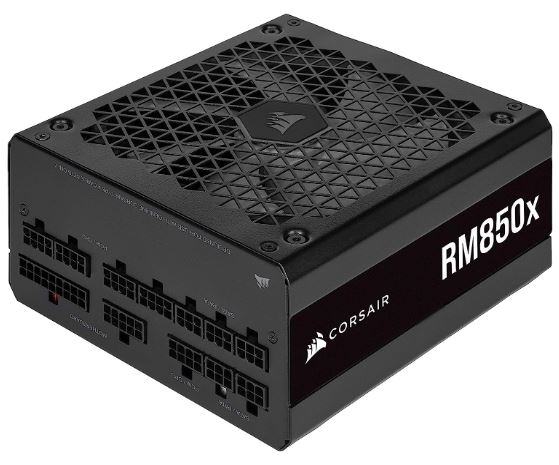
One standout feature of the Corsair RM850x is its fully modular design. This allows for easy cable management, as you only need to connect the cables required for your specific system configuration. It reduces clutter, enhances airflow, and provides a cleaner overall aesthetic.
Equipped with a low-noise fan and Zero RPM mode, the RM850x operates quietly, even during demanding tasks. The fan remains idle under low to moderate loads, contributing to a peaceful, distraction-free computing environment.
The Corsair RM850x offers a maximum power output of 850 watts, making it suitable for high-performance gaming systems and workstations. It can easily handle the power requirements of multiple graphics cards, processors, and other power-hungry components.
Built with high-quality components, including Japanese capacitors, the RM850x ensures long-lasting durability and stable power delivery. It incorporates advanced over-voltage, over-current, and short-circuit protection, safeguarding your valuable components from potential damage.
With its sleek and elegant black design, the Corsair RM850x seamlessly integrates into any system build. It offers ample power, impressive efficiency, and silent operation, making it a reliable choice for enthusiasts and professionals.
In conclusion, the Corsair RM850x sets a high standard for power supplies with its efficiency, modular design, and quiet operation. Whether you’re a gamer, content creator, or workstation user, this PSU provides the power and stability to fuel your system’s performance.
Pros:-
Efficiency: The 80 PLUS Gold certification ensures excellent energy efficiency, reducing power wastage and saving on electricity costs.
Fully Modular Design: The fully modular design allows for easy cable management, minimizing clutter and improving airflow within the system. It also provides a clean and organized look to the build.
Low-Noise Fan: The RM850x has a low-noise fan that operates quietly, even under demanding workloads. The Zero RPM mode ensures silent operation during low to moderate system loads.
High Power Output: With a maximum power output of 850 watts, this PSU can handle the requirements of high-performance gaming systems and workstations with multiple power-hungry components.
Quality Components: Using Japanese capacitors and advanced protection features, such as over-voltage and short-circuit protection, ensures long-lasting durability and reliable power delivery to safeguard your system components.
Cons:-
Price: The Corsair RM850x is a premium power supply, which means it comes at a higher price point than some other models in the market. However, the quality and performance it offers justify the investment.
Overkill for Basic Systems: The RM850x’s high power output may be excessive for basic systems with minimal power requirements. In such cases, opting for a lower-wattage PSU might be more cost-effective.
No RGB Lighting: While some users appreciate RGB lighting in their system components, the Corsair RM850x does not offer this feature. However, this is subjective and may not be a drawback for those seeking a clean and minimalist design.
Overall, the Corsair RM850x offers exceptional efficiency, modular design, quiet operation, and reliable performance. While it may come at a higher price, it provides the power and stability needed for demanding gaming setups and professional workstations.
Check Price on Amazon2. Corsair RM1000x – Best Power Supply For Gaming
The Corsair RM1000x is a remarkable Fully Modular ATX Power Supply that combines high performance with exceptional efficiency. Designed to meet the demands of power-hungry systems, this PSU delivers robust power output and reliable operation.
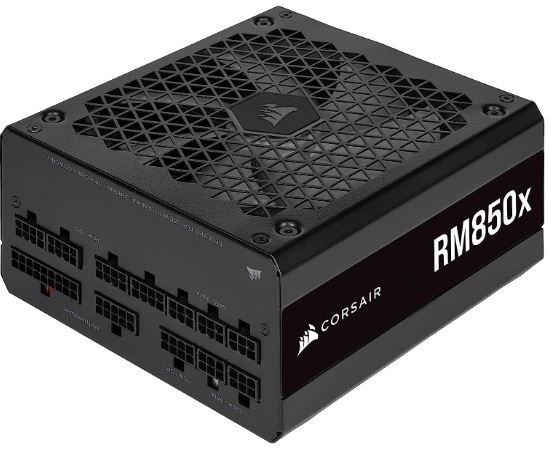
Featuring an 80 PLUS Gold certification, the RM1000x ensures outstanding energy efficiency, minimizing power wastage and reducing operating costs. It provides a sustainable power solution for gamers, content creators, and professionals seeking maximum performance.
The fully modular design of the Corsair RM1000x allows for easy cable management, enabling users to connect only the necessary cables for their specific system configuration. This promotes a clean and organized build, optimizing airflow and reducing clutter.
Equipped with a low-noise fan and Zero RPM mode, the RM1000x operates silently under normal and moderate loads. The fan remains idle, providing a whisper-quiet computing environment, while the power supply maintains stability and reliability.
With its 1000-watt power output, the RM1000x can handle demanding systems with multiple graphics cards, high-performance processors, and power-hungry components. It ensures consistent power delivery, enabling smooth and uninterrupted performance.
Built with high-quality components, including Japanese capacitors and advanced protection features, the Corsair RM1000x ensures long-term reliability and safeguards against electrical issues. It offers over-voltage, over-current, and short-circuit protection, ensuring the safety of your valuable components.
In conclusion, the Corsair RM1000x is a powerful and efficient PSU that delivers the necessary power for high-performance systems.
Its fully modular design, low-noise operation, and exceptional reliability make it a solid choice for enthusiasts and professionals seeking top-tier performance for their demanding computing needs.
Pros:-
High Power Output: With a maximum power output of 1000 watts, the Corsair RM1000x can handle even the most demanding systems, including multiple graphics cards and power-hungry components.
Energy Efficiency: The 80 PLUS Gold certification ensures excellent energy efficiency, reducing power wastage and lowering operating costs over time.
Fully Modular Design: The fully modular design allows easy cable management, providing a clean and organized build while improving airflow and reducing clutter.
Low-Noise Operation: Equipped with a low-noise fan and Zero RPM mode, the RM1000x operates quietly under normal and moderate loads, creating a peaceful computing environment.
Quality Components and Protection Features: Built with high-quality components, including Japanese capacitors, the RM1000x offers long-term reliability. It incorporates advanced protection features, such as over-voltage, over-current, and short-circuit protection, to safeguard your system components.
Cons:-
Price: As a high-performance power supply, the Corsair RM1000x comes at a higher price point than lower-wattage models. However, it offers the power and reliability needed for demanding systems.
Overkill for Basic Systems: The RM1000x’s high power output may be excessive for basic systems with lower power requirements, making opting for a lower-wattage PSU more cost-effective.
No RGB Lighting: If you prefer RGB lighting in your system components, the RM1000x does not include this feature. However, this is subjective and may not be a drawback for those prioritizing power and efficiency over aesthetics.
The Corsair RM1000x is a powerful and efficient PSU that delivers reliable performance for high-end systems. While it may be more expensive and may not suit basic setups, its high power output, energy efficiency, modular design, and quiet operation make it an excellent choice for enthusiasts and professionals seeking top-tier power and stability.
Check Price on Amazon2. EVGA
When choosing a power supply unit (PSU) brand, EVGA stands tall as one of the best in the market. Renowned for their commitment to quality, innovation, and reliability, EVGA has earned a well-deserved reputation among enthusiasts and professionals.
One of the key strengths of EVGA as a PSU brand is its dedication to performance. Their power supplies are meticulously engineered to deliver consistent and stable power to demanding systems. Whether you’re a gamer, content creator, or professional, EVGA PSUs provide the necessary power to fuel your ambitions.
EVGA’s commitment to quality is evident in its use of high-grade components and rigorous testing procedures. Their PSUs incorporate top-tier features like Japanese capacitors and advanced protection mechanisms, ensuring durability and safeguarding your system from electrical issues.
Another factor that sets EVGA apart is its extensive product lineup. They offer various PSUs catering to different budgets and system requirements. EVGA covers whether you need a compact PSU for a small form factor build or a high-wattage unit for a high-performance system.
EVGA’s customer support is often praised as one of the best in the industry. They provide excellent warranty coverage and responsive assistance, ensuring peace of mind for customers. Their dedication to customer satisfaction further reinforces their position as one of the best PSU brands.
In conclusion, EVGA’s commitment to performance, quality, and customer satisfaction makes them one of the best PSU brands. With their wide product range and exceptional support, EVGA ensures that your system receives the power it needs while offering reliability and peace of mind. When powering your system, EVGA is a name you can trust.
Strengths and weaknesses of EVGA:-
Strengths of EVGA:-
Superior Customer Support: EVGA is widely recognized for its exceptional customer support. The company’s dedication to providing prompt and helpful assistance sets them apart from competitors, ensuring a positive customer experience.
Innovative Product Design: EVGA continually pushes the boundaries of innovation, introducing cutting-edge technologies and features in its products. From high-performance graphics cards to power supplies and motherboards, EVGA consistently delivers products that meet the demands of enthusiasts and gamers.
Reliability and Quality: EVGA’s products are known for their reliability and quality. The brand utilizes top-tier components and rigorous testing procedures to ensure long-lasting performance and durability, instilling consumer confidence.
Weaknesses of EVGA:-
Limited Product Range: Compared to some competitors, EVGA’s product range may be more focused and narrow. While they excel in certain areas, customers seeking a broader selection of products may find their options limited.
Higher Price Point: EVGA’s reputation for quality and performance is reflected in its pricing. Their products often come with a premium price tag, which may deter budget-conscious consumers.
Availability: The availability of EVGA products can vary depending on the region. Some customers may experience difficulty accessing their desired items, particularly in certain markets.
Understanding the strengths and weaknesses of EVGA allows consumers to make informed decisions. EVGA’s exceptional customer support, innovative designs, and commitment to quality set them apart in the industry.
However, factors such as limited product range, higher pricing, and availability should be considered when evaluating their offerings. EVGA strives for excellence while addressing areas of improvement, further solidifying its position as a reputable brand in the market.
Let us learn more about two of its best products:-
1. EVGA 600W
The EVGA 600W power supply is a reliable and affordable choice for those seeking efficient and stable power delivery for their systems. With its 80 Plus Certified rating, this PSU offers excellent energy efficiency, ensuring minimal power wastage and reduced operating costs.
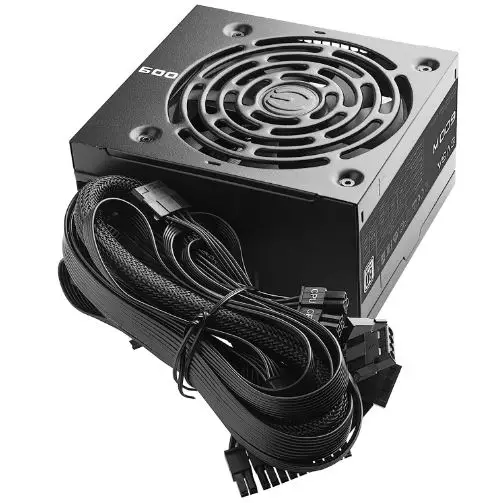
Equipped with a maximum power output of 600W, the EVGA 600W power supply provides ample power for mid-range gaming systems and workstations. It can handle the power requirements of various components, including processors, graphics cards, and storage devices.
The EVGA 600W power supply incorporates various features to ensure reliable operation. Heavy-duty protections such as over-voltage, under-voltage, over-current, and short-circuit protection safeguards your system from potential electrical issues, enhancing its longevity.
The quiet fan of the EVGA 600W power supply ensures efficient cooling while maintaining low noise levels. It operates smoothly, even under demanding workloads, ensuring a quieter computing experience.
With its affordable price point, the EVGA 600W power supply offers great value for budget-conscious users. It provides reliable and stable power delivery without compromising on quality.
The EVGA 600W power supply is designed with a compact size that fits seamlessly into various system builds. Whether you have a standard desktop or a compact form factor case, this PSU can be easily accommodated.
The EVGA 600W power supply delivers reliable and efficient power for mid-range systems. With its 80 Plus Certified rating, robust protection features, quiet fan, and affordable price, it is a solid choice for users seeking a reliable and cost-effective power supply solution.
Pros:-
Affordability: The EVGA 600W power supply offers a cost-effective solution for users on a budget, providing reliable power delivery without breaking the bank.
Energy Efficiency: With its 80 Plus Certified rating, the EVGA 600W power supply ensures excellent energy efficiency, reducing power wastage and lowering operating costs.
Reliable Performance: Equipped with heavy-duty protections such as over-voltage, under-voltage, over-current, and short-circuit protection, the EVGA 600W power supply ensures stable and reliable operation, protecting your system components.
Quiet Operation: The quiet fan of the EVGA 600W power supply ensures efficient cooling while maintaining low noise levels, contributing to a quieter computing experience.
Compact Size: The compact size of the EVGA 600W power supply allows for easy integration into various system builds, making it suitable for both standard desktops and compact form factor cases.
Cons:-
Limited Power Capacity: With a maximum power output of 600W, the EVGA 600W power supply may not be sufficient for high-end gaming systems or workstations with power-hungry components.
Non-Modularity: The EVGA 600W power supply does not feature a modular design, meaning all the cables are permanently attached. This may result in a less tidy cable management setup than modular power supplies.
Lack of Advanced Features: The EVGA 600W power supply does not offer some of the advanced features found in higher-end models, such as fully modular design, RGB lighting, or advanced cooling technologies. However, this is to be expected at this price point.
In conclusion, the EVGA 600W power supply offers affordable and reliable power delivery for mid-range systems. While it may have limitations regarding power capacity and advanced features, its affordability, energy efficiency, reliable performance, quiet operation, and compact size make it a suitable choice for budget-conscious users needing a dependable power supply.
Check Price on Amazon2. EVGA 700 GD
The EVGA 700 GD power supply is a high-quality option that combines reliability, efficiency, and value. With its 80+ Gold certification and a maximum power output of 700W, this PSU offers excellent energy efficiency and sufficient power for mid-range to high-end systems.
One standout feature of the EVGA 700 GD is its reliable performance. Built with high-quality components, it delivers stable and consistent power to your system, ensuring smooth operation even during demanding tasks.
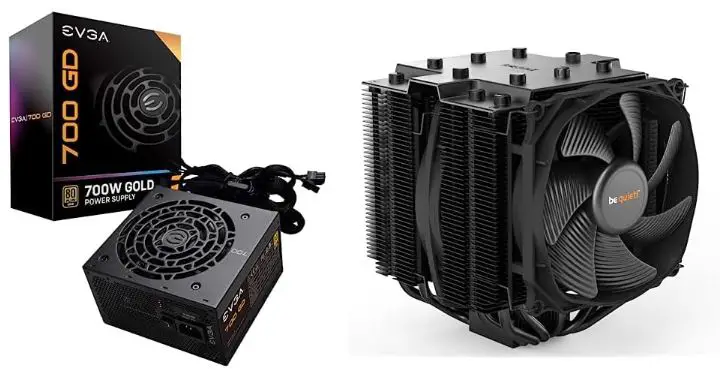
The 80+ Gold certification guarantees exceptional energy efficiency, minimizing power wastage and reducing operating costs. This makes the EVGA 700 GD an excellent choice for those who prioritize efficiency and want to lower their electricity bills.
The EVGA 700 GD comes with a 5-year warranty, demonstrating the manufacturer’s confidence in its product’s reliability. This provides peace of mind for users, knowing they are covered in any issues.
With its compact size and fully modular design, the EVGA 700 GD offers convenient cable management, allowing for a cleaner and more organized build. This enhances airflow and reduces clutter, promoting better cooling and system performance.
The EVGA 700 GD features over-, over-current, under-voltage, and short-circuit protections, safeguarding your valuable components from potential damage. This adds an extra layer of security to your system.
The EVGA 700 GD power supply delivers reliable performance, excellent energy efficiency, and a convenient modular design. Its 80+ Gold certification, compact size, and comprehensive protection features make it a reliable and efficient power supply for mid-range to high-end systems.
Pros:-
Reliable Performance: The EVGA 700 GD power supply offers reliable and stable performance, delivering consistent power to your system even during demanding tasks.
Energy Efficiency: With its 80+ Gold certification, the EVGA 700 GD provides excellent energy efficiency, reducing power wastage and lowering electricity costs.
Convenient Modular Design: The fully modular design of the EVGA 700 GD allows for easy cable management, resulting in a cleaner and more organized build. This promotes better airflow and improved cooling.
Comprehensive Protection Features: The EVGA 700 GD comes with over-voltage, over-current, under-voltage, and short-circuit protections, ensuring the safety of your system components and preventing damage caused by electrical issues.
5-Year Warranty: EVGA offers a 5-year warranty with the 700 GD power supply, providing peace of mind and assurance of the product’s reliability.
Cons:-
Limited Wattage Output: With a maximum power output of 700W, the EVGA 700 GD may not be suitable for high-end systems with power-hungry components or multiple graphics cards.
Non-Modular Cables: The EVGA 700 GD does not feature fully modular cables, meaning some cables are permanently attached. This may result in a less tidy cable management setup than fully modular power supplies.
Noisy Operation at High Loads: Some users have reported that the fan noise of the EVGA 700 GD can become noticeable under heavy loads. However, this may vary depending on the specific system configuration and user preferences.
In conclusion, the EVGA 700 GD power supply offers reliable performance, energy efficiency, and a convenient modular design. While it may have limitations regarding wattage output and non-modular cables, its comprehensive protection features and 5-year warranty make it a solid choice for users seeking a dependable and efficient power supply for their mid-range systems.
Check Price on Amazon3. Seasonic
Regarding power supply units (PSUs), Seasonic stands out as one of the best brands in the industry. Renowned for their exceptional quality, innovation, and reliability, Seasonic has earned a well-deserved reputation among enthusiasts and professionals.
One of the key strengths of Seasonic as a PSU brand is its commitment to excellence. Their PSUs are crafted meticulously and utilize top-grade components to ensure reliable and efficient power delivery. Seasonic power supplies are built to withstand the demands of high-performance systems and provide stable power to critical components.
Seasonic’s dedication to energy efficiency is exemplified by its wide range of PSUs with 80 PLUS certifications, including 80 PLUS Bronze, Silver, Gold, Platinum, and Titanium. These certifications signify outstanding energy efficiency, reducing power consumption and lowering operating costs over time.
Another notable aspect of Seasonic’s PSUs is their silent operation. Equipped with advanced cooling technologies and high-quality fans, Seasonic power supplies maintain optimal temperatures while operating quietly, contributing to a peaceful computing environment.
Seasonic offers a diverse lineup of PSUs to cater to various system configurations and power requirements. Whether you’re a gamer, content creator, or professional, Seasonic has a PSU that suits your needs, providing the necessary power, stability, and efficiency for your system.
In conclusion, Seasonic has established itself as one of the best PSU brands by consistently delivering high-quality, efficient, and reliable power supplies.
With their commitment to excellence, energy efficiency, silent operation, and a wide range of options, Seasonic is the go-to brand for enthusiasts and professionals seeking the best power supply solution for their systems.
Strengths and weaknesses of Seasonic:-
Strengths of Seasonic:-
Exceptional Build Quality: Seasonic power supplies are renowned for their exceptional build quality. The brand utilizes high-quality components, advanced engineering, and rigorous testing to ensure reliable and durable products.
Efficiency and Performance: Seasonic power supplies consistently achieve high levels of efficiency, often carrying 80+ certifications such as 80+ Gold or Platinum. This translates to reduced power wastage, lower operating temperatures, and potential cost savings over time.
Silent Operation: Seasonic prioritizes quiet computing with their power supplies. Many models incorporate advanced fan technologies, optimized fan curves, and noise reduction features to provide near-silent operation, allowing users to enjoy a peaceful computing environment.
Variety of Offerings: Seasonic offers a diverse range of power supply options, catering to different power requirements and budgets. From entry-level models to high-end units, their product lineup ensures a suitable choice for various user needs.
Weaknesses of Seasonic:-
Higher Price Range: Seasonic power supplies often have a higher price tag than competing brands. The premium quality and performance may make them less accessible for budget-conscious users.
Limited Availability of Features: While Seasonic power supplies excel in terms of build quality and efficiency, they may lack certain advanced features found in other brands, such as digital control, extensive monitoring, or advanced connectivity options. Users seeking these specific features may need to explore alternative options.
Design Aesthetics: Seasonic power supplies have a minimalist design approach that may not appeal to users seeking more visually striking or customizable options. While subjective, some individuals may prefer power supplies with more flashy aesthetics.
Understanding the strengths and weaknesses of Seasonic allows consumers to make informed decisions. While Seasonic’s exceptional build quality, efficiency, and silent operation make them popular among PC enthusiasts, factors such as pricing, feature availability, and design preferences should be considered.
Seasonic continues to evolve and innovate, addressing limitations and solidifying its position as a reputable brand in the power supply market.
Let us learn more about two of its best products:-
1. Seasonic Focus GX-850
The Seasonic Focus GX-850 power supply is a pinnacle of engineering prowess and innovation, setting a new standard for gaming enthusiasts and power-hungry applications.
With its cutting-edge features and remarkable specifications, this 850W 80+ Gold full-modular power supply ensures an unrivaled experience for discerning users.
One of the standout features of the Seasonic Focus GX-850 is its fan control capability, which operates seamlessly in fanless, silent, and cooling modes.
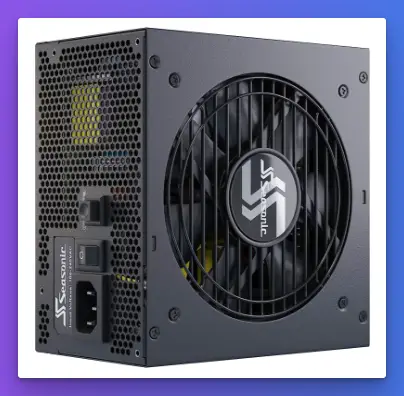
This intelligent system ensures whisper-quiet operation during low-power demands, with the ability to adjust cooling performance based on system load dynamically. This feature and the power supply’s 10-year warranty guarantee long-lasting reliability for your gaming and high-performance computing needs.
Designed with utmost attention to detail, the Seasonic Focus GX-850 boasts a highly efficient 80+ Gold certification, delivering exceptional power efficiency and minimizing energy wastage. Its full-modular design allows for easy cable management, enabling a clean and organized setup that enhances airflow and reduces clutter within your PC chassis.
Whether engaging in intense gaming sessions, content creation, or running resource-intensive applications, the Seasonic Focus GX-850 provides the perfect power solution. Its 850W output ensures stable and reliable power delivery, even under heavy loads, ensuring optimal performance and preventing any dips or fluctuations that could impact your system’s stability.
Invest in the Seasonic Focus GX-850 today and experience the pinnacle of power supply technology. Unlock the true potential of your gaming rig or high-performance PC with this remarkable power supply unit that embodies power, efficiency, and longevity.
Pros:-
Exceptional Power Efficiency: The Seasonic Focus GX-850 power supply boasts an impressive 80+ Gold certification, ensuring high power efficiency and reduced energy wastage.
Intelligent Fan Control: With the ability to operate in fanless, silent, and cooling mode, this power supply offers a versatile cooling system that adjusts dynamically based on system load, providing optimal performance and quiet operation.
Full-Modular Design: The full-modular design of the Seasonic Focus GX-850 allows for easy cable management, improving airflow and reducing clutter within the PC chassis for a cleaner and more organized setup.
High Power Output: With an output of 850W, this power supply delivers stable and reliable power even under heavy loads, making it ideal for gaming, resource-intensive applications, and high-performance computing.
Long Warranty: The 10-year warranty offered by Seasonic demonstrates the brand’s confidence in the product’s quality and reliability, providing peace of mind for users.
Cons:-
Price: The Seasonic Focus GX-850 power supply may be relatively higher in price than other power supplies in the market, which could be a limiting factor for budget-conscious buyers.
Overkill for Low-Power Systems: For users with low-power systems or basic computing needs, the 850W output of this power supply may be excessive and unnecessary, resulting in higher costs without utilizing its full potential.
Limited Availability: Depending on the region, the availability of the Seasonic Focus GX-850 power supply may vary, making it less accessible for some users.
No RGB Lighting: While not essential for everyone, some users may prefer power supplies with built-in RGB lighting options to match their overall system aesthetics, which the Seasonic Focus GX-850 does not provide.
The Seasonic Focus GX-850 power supply offers impressive features, power efficiency, and reliability. However, potential buyers should consider their specific needs and budget before purchasing.
2. Seasonic S12III 500 SSR-500GB3 500W
Introducing the Seasonic S12III 500 SSR-500GB3 500W power supply, a true masterpiece of engineering that combines exceptional performance, smart functionality, and unrivaled reliability.
Designed to meet the demands of both casual users and enthusiasts, this 80+ Bronze ATX12V & EPS12V power supply guarantees a seamless and efficient power delivery to your system.
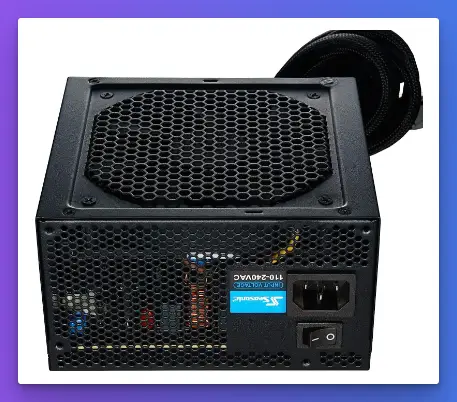
With its direct cable wire output, the Seasonic S12III 500 ensures clean power distribution and minimizes voltage drop, enhancing system stability and overall performance.
This power supply is equipped with a smart and silent fan control mechanism, employing a double ball bearing fan that optimizes cooling while maintaining near-silent operation, even during heavy workloads.
Built to withstand demanding conditions, the Seasonic S12III 500 utilizes high-quality components, including a 105 °C Japanese capacitor, ensuring reliable and durable performance over the long term. The power supply’s robust construction guarantees stability, even in challenging environments and high-temperature conditions.
As a testament to its exceptional quality, the Seasonic S12III 500 has a 5-year warranty, providing peace of mind and assurance of long-lasting support.
Upgrade your PC with the Seasonic S12III 500 SSR-500GB3 500W power supply and experience silent efficiency. Unleash your system’s true potential while enjoying the benefits of superior power delivery and enhanced reliability. Invest in this power supply today and elevate your computing experience.
Pros:-
Efficient Power Delivery: The Seasonic S12III 500 SSR-500GB3 500W power supply boasts an 80+ Bronze certification, ensuring efficient power delivery and reduced energy consumption.
Smart and Silent Fan Control: With its smart fan control mechanism and double ball bearing fan, this power supply provides optimal cooling performance while maintaining near-silent operation, even during demanding tasks.
Direct Cable Wire Output: The direct cable wire output design enhances power distribution, minimizing voltage drop and improving overall system stability.
High-Quality Components: The Seasonic S12III 500 utilizes a 105 °C Japanese capacitor and other high-quality components, ensuring reliability, durability, and longevity.
5-Year Warranty: With a 5-year warranty, Seasonic demonstrates its confidence in the product’s quality, providing users peace of mind and long-term support.
Cons:-
Limited Power Capacity: The 500W power capacity of the Seasonic S12III 500 may be insufficient for high-end gaming rigs or systems with multiple high-power components. Users with such configurations may need to opt for a higher-wattage power supply.
Non-Modular Design: The power supply has a non-modular design, meaning all cables are permanently attached. This may result in more cable clutter inside the PC case and make cable management more challenging.
Lack of Advanced Features: The Seasonic S12III 500 does not include advanced features such as modular cables, RGB lighting, or fully digital control. This may be a drawback for users seeking more customization options or enhanced aesthetics.
Bronze Efficiency Rating: While the power supply offers decent efficiency, it falls short of the higher efficiency ratings, such as 80+ Gold or 80+ Platinum, which may impact energy savings in the long run.
Consider your specific power requirements and system configuration before choosing the Seasonic S12III 500 SSR-500GB3 500W power supply. While it offers reliable performance and silent operation, users with more demanding setups or those seeking advanced features may need to explore other options.
4. Thermaltake
When it comes to power supply units (PSUs), one brand that stands out for its exceptional quality and reliability is Thermaltake. Thermaltake is committed to delivering top-notch products and has firmly established itself as one of the best PSU brands for casual use.
Thermaltake PSUs are engineered with precision and attention to detail, ensuring optimal performance and stability for casual users. Whether building a home office PC, browsing the web, or indulging in light gaming, Thermaltake PSUs provide the necessary power to meet your needs.
One of the key advantages of Thermaltake PSUs is their reliability. Built with high-quality components and advanced circuitry, these PSUs offer excellent protection features like over-voltage, over-current, and short-circuit protection, safeguarding your system from potential damage.
Thermaltake PSUs also prioritize energy efficiency, helping you save on electricity bills while minimizing environmental impact. With their 80+ certification and efficient power delivery, these PSUs are designed to reduce energy wastage without compromising performance.
Furthermore, Thermaltake offers a wide range of PSU options to cater to different power requirements and budgets, ensuring that casual users can find a suitable solution.
Investing in a Thermaltake PSU for casual use means choosing a brand synonymous with reliability, performance, and value. Experience peace of mind and enjoy seamless power delivery with Thermaltake, the preferred choice for casual users seeking dependable PSU solutions.
Strengths and weaknesses of Thermaltake:-
Strengths of Thermaltake:-
Product Range and Innovation: Thermaltake offers a wide range of products, including power supplies, cooling solutions, cases, and peripherals. Their commitment to innovation is evident in their unique designs and cutting-edge features that cater to the needs of PC enthusiasts and gamers.
Build Quality and Reliability: Thermaltake products are known for their solid build quality and reliability. The brand utilizes high-quality materials and undergoes rigorous testing to ensure durability and long-term performance.
Customization and Aesthetics: Thermaltake understands the importance of customization and aesthetics. Their products often feature customizable RGB lighting, modular designs, and sleek aesthetics, allowing users to personalize their setups and create visually stunning PC builds.
Cooling Solutions: Thermaltake is recognized for its extensive range of cooling solutions, including air coolers, all-in-one liquid coolers, and case fans. These cooling solutions are designed to effectively dissipate heat, keeping temperatures in check and ensuring optimal system performance.
Weaknesses of Thermaltake:-
Pricing: Thermaltake products, especially their high-end offerings, can be relatively expensive compared to some competitors. This higher pricing may make them less accessible for budget-conscious consumers.
Software Integration: While Thermaltake offers software control for its RGB lighting and other features, some users have reported difficulties with software integration and usability. Improvements in software functionality and user experience could enhance overall user satisfaction.
Availability of Support and Warranty: Customers have reported challenges with support and warranty services in certain regions. Strengthening customer support networks and promptly addressing warranty issues would improve customer experience.
Understanding the strengths and weaknesses of Thermaltake allows consumers to make informed decisions. While Thermaltake’s product range, build quality, customization options, and cooling solutions make them a popular choice, factors such as pricing, software integration, and support should be considered when evaluating their offerings.
Thermaltake continues to innovate and address limitations, further solidifying its position as a reputable brand in the PC hardware industry.
Let us learn more about two of its best products:-
1. Thermaltake Toughpower GX1
Introducing the Thermaltake Toughpower GX1, a remarkable power supply that combines unwavering reliability, impressive efficiency, and exceptional performance.
Designed to meet the demands of PC enthusiasts and gamers, the Toughpower GX1 delivers an outstanding power solution for a wide range of systems.
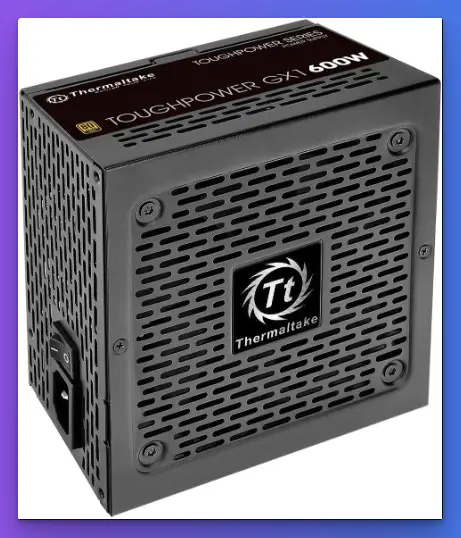
With its 80+ Gold certification, the Toughpower GX1 ensures high power efficiency, reducing energy waste and lowering operating costs. This efficiency is complemented by its continuous power capability, providing a stable and reliable power output even during demanding tasks.
The Toughpower GX1 is built to support multi-GPU configurations with its SLI/CrossFire ready compatibility, enabling gamers to unleash the full potential of their graphics cards without compromising performance. This power supply is engineered to deliver sufficient power to meet the needs of high-end gaming rigs and resource-intensive applications.
Featuring the latest ATX 12V V2.4/EPS V2.92 standards, the Toughpower GX1 guarantees seamless compatibility with modern PC systems. While it is a non-modular power supply, its robust construction and high-quality components ensure efficient power delivery and excellent system stability.
Thermaltake stands behind the Toughpower GX1’s quality with a 5-year warranty, providing users with long-term peace of mind and support.
Upgrade your PC with the Thermaltake Toughpower GX1 and experience the true power of reliability and efficiency. Elevate your gaming experience and tackle resource-intensive tasks confidently, knowing that a trusted and high-performance PSU powers your system. Unleash the full potential of your rig with the Toughpower GX1.
Pros:-
High Efficiency: The Thermaltake Toughpower GX1 power supply boasts an 80+ Gold certification, ensuring excellent energy efficiency and reducing power wastage.
Continuous Power: With its continuous power capability, this PSU provides a stable and reliable power output even during demanding tasks, ensuring system stability and performance.
SLI/CrossFire Ready: The Toughpower GX1 is compatible with multi-GPU configurations, allowing gamers to maximize graphics performance without compromising power delivery.
ATX 12V V2.4/EPS V2.92 Compliance: This power supply meets the latest standards, ensuring seamless compatibility with modern PC systems and components.
5-Year Warranty: Thermaltake backs the Toughpower GX1 with a 5-year warranty, demonstrating their confidence in the product’s quality and providing users with long-term peace of mind.
Cons:-
Non-Modular Design: The Toughpower GX1 is a non-modular power supply, meaning all cables are permanently attached. This can result in more cable clutter inside the PC case and may require extra effort for cable management.
Limited Customization: Due to its non-modular design, users have limited flexibility in cable management and customization options compared to modular power supplies.
Lack of Advanced Features: The Toughpower GX1 does not include advanced features such as fully modular cables, RGB lighting, or advanced fan control. Some users seeking these additional features may need to explore other options.
Wattage Limitations: With a power output of 600W, the Toughpower GX1 may not be sufficient for high-end gaming systems with multiple high-power components. Users with such configurations may need to consider a higher-wattage PSU.
Consider your specific power requirements and system configuration before choosing the Thermaltake Toughpower GX1 power supply. While it offers excellent efficiency, compatibility, and reliability, users seeking more customization options or higher power outputs may need to explore other alternatives.
2. Thermaltake Toughpower GF1 850W
Introducing the Thermaltake Toughpower GF1 850W, a powerhouse of a power supply that delivers exceptional performance, unmatched efficiency, and unrivaled reliability. Designed for enthusiasts and demanding users, this 80+ Gold-certified PSU sets a new standard in power supply technology.
With its 850W power output, the Toughpower GF1 can handle even the most power-hungry systems. It provides a stable and reliable power delivery to support high-end gaming, intense multimedia tasks, and resource-intensive applications.
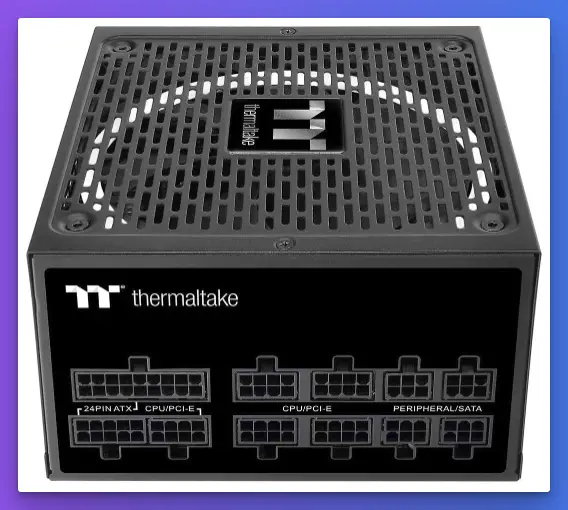
Equipped with a full modular design, this power supply offers unparalleled flexibility and convenience in cable management, allowing users to connect only the necessary cables, reducing clutter, and enhancing airflow within the PC chassis.
The Toughpower GF1 utilizes an ultra-quiet 140mm hydraulic bearing fan with smart zero fan technology. This ensures optimal cooling performance while maintaining near-silent operation, even during heavy workloads. The fan operates intelligently, activating only when needed, further enhancing the overall efficiency and longevity of the power supply.
Thermaltake’s commitment to quality and reliability is evident in the Toughpower GF1, backed by an impressive 10-year warranty. This warranty provides peace of mind and demonstrates the brand’s confidence in the product’s durability and long-term performance.
Upgrade your system with the Thermaltake Toughpower GF1 850W power supply and experience a new level of power and efficiency. Enjoy the benefits of a full modular design, exceptional cooling, and a decade-long warranty. Unleash the true potential of your PC with the Toughpower GF1.
Pros:-
High Power Output: The Thermaltake Toughpower GF1 850W power supply offers ample power to support demanding systems, making it suitable for high-end gaming, multimedia tasks, and resource-intensive applications.
Efficiency and Certification: With its 80+ Gold certification, the Toughpower GF1 ensures high energy efficiency, minimizing power wastage and reducing electricity costs.
Full Modular Design: The power supply’s full modular design allows for easy cable management, enabling a clean and organized setup that improves airflow and reduces clutter within the PC chassis.
Ultra-Quiet Operation: Equipped with a 140mm hydraulic bearing fan and smart zero fan technology, the Toughpower GF1 provides efficient cooling while maintaining near-silent operation, ensuring a quiet and comfortable computing experience.
Long Warranty: Thermaltake offers an impressive 10-year warranty for the Toughpower GF1, reflecting the brand’s confidence in the product’s quality and providing long-term peace of mind to users.
Cons:-
Price: The Toughpower GF1 850W power supply may be relatively higher than lower-wattage options or non-modular power supplies, which could be a consideration for budget-conscious buyers.
Overkill for Lower-Power Systems: For users with lower-power systems or basic computing needs, the 850W power output of the Toughpower GF1 may be excessive, resulting in higher costs without utilizing the full potential of the power supply.
Size and Space: The larger 140mm fan and full modular design of the Toughpower GF1 may require more space within the PC case, so users should ensure their case can accommodate its dimensions.
Limited Availability: Depending on the region, the availability of the Thermaltake Toughpower GF1 850W power supply may vary, making it less accessible for some users.
Consider your specific power requirements and budget before choosing the Thermaltake Toughpower GF1 850W power supply. While it offers high power output, efficiency, and a long warranty, users with lower-power systems or those seeking more budget-friendly options may find other alternatives more suitable for their needs.
5. Be Quiet!
When selecting the best power supply unit (PSU) for your system, one brand that consistently stands out is Be Quiet!. With its unwavering commitment to excellence, Be Quiet! cemented its position as one of the best PSU brands.
Be Quiet! PSUs are renowned for their exceptional quality, unmatched performance, and near-silent operation. These PSUs are designed with meticulous attention to detail, employing advanced technologies to deliver reliable and efficient power to your system.
One of the standout features of Be Quiet! PSUs is their focus on quiet operation. The brand understands the importance of a peaceful computing environment and incorporates innovative designs, such as advanced fan technology and noise-reducing components, to ensure whisper-quiet performance.
In addition to their silent operation, Be Quiet! PSUs offer impressive efficiency ratings, ensuring optimal power utilization and reduced energy consumption. These PSUs often carry 80+ Gold or 80+ Platinum certifications, underscoring their commitment to energy efficiency and environmental sustainability.
Be Quiet! PSUs also prioritize reliability and durability, utilizing high-quality components and rigorous testing procedures to deliver rock-solid performance. They offer excellent protection features, including over-voltage, over-current, and short-circuit protection, safeguarding your valuable hardware from potential damage.
Choose Be Quiet! as your PSU brand and experience the benchmark of quality, performance, and silence. Elevate your system’s power delivery confidently and enjoy a tranquil computing experience with Be Quiet!’s exceptional PSUs.
Strengths and weaknesses of Be Quiet!:-
Strengths of Be Quiet!:-
Silent Operation: Be Quiet! is renowned for its focus on silent computing. Their products, including power supplies, cooling solutions, and case fans, are designed with advanced technologies and innovative designs to minimize noise levels and provide a quiet computing experience.
Build Quality and Performance: Be Quiet! products exhibit excellent build quality, utilizing high-quality materials and components. Their power supplies deliver stable power output, efficient energy conversion, and reliable performance, meeting the demands of PC enthusiasts and gamers.
Design Aesthetics: Be Quiet! excels in design aesthetics, offering sleek and visually appealing products. Their attention to detail and minimalist approach result in clean, sophisticated designs that enhance the overall look of PC builds.
Efficiency and Reliability: Be Quiet! power supplies often carry 80+ certifications, such as 80+ Gold or 80+ Platinum, ensuring high energy efficiency and reduced power wastage. Additionally, their products are known for their reliability and long-term performance.
Weaknesses of Be Quiet!:-
Limited Availability: Be Quiet! products may have limited availability in certain regions or markets. This could pose challenges for potential customers with difficulty accessing their desired products.
Pricing: Be Quiet! products, particularly their high-end offerings, tend to be in the higher price range. While they offer premium quality and performance, the higher cost may be a limiting factor for budget-conscious consumers.
Limited Product Range: Be Quiet! may have a more focused product range than competitors. While they excel in power supplies and cooling solutions, customers seeking a broader selection of products may find their options limited.
Understanding the strengths and weaknesses of Be Quiet! Allows consumers to make informed decisions. Be Quiet!’s focus on silent operation, build quality, design aesthetics, and efficiency make them a popular choice among PC enthusiasts.
However, factors such as limited availability, pricing, and product range should be considered when evaluating their offerings. Be Quiet! Continues to innovate and address limitations, further solidifying its position as a reputable brand in the PC hardware industry.
Let us learn more about two of its best products:-
1. Be quiet! BN505
Introducing the Be Quiet! BN505 power supply, a pinnacle of performance, reliability, and silent operation. This PSU delivers unparalleled power and efficiency for a seamless computing experience and is designed to cater to demanding gamers and PC enthusiasts.
Equipped with an ATX 3.0 form factor and an impressive 850W power output, the Be Quiet! BN505 provides ample power to support high-performance systems, including PCIe 5.0 GPUs and 6+2 pin connectors. It ensures a stable and reliable power supply, even during intense gaming sessions or resource-intensive tasks.
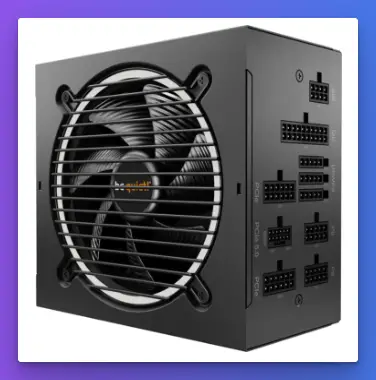
The BN505 features an 80 Plus® Gold certification, guaranteeing exceptional energy efficiency and reducing power wastage. This helps lower electricity bills and contributes to a greener and more sustainable computing environment.
With its modular design, this power supply offers the convenience of custom cable management, allowing users to connect only the necessary cables. This results in improved airflow, reduced cable clutter, and a cleaner system build.
One of the standout features of the Be Quiet! BN505 is its silent operation. The included 120mm be quiet! fan operates quietly, ensuring efficient cooling while keeping noise levels minimal. This enables a peaceful and distraction-free computing experience.
Upgrade your system with the Be Quiet! BN505 power supply and experience the perfect balance of power, efficiency, and silence. Enjoy the benefits of modular design, high-quality components, and exceptional cooling performance. Unleash the true potential of your PC with the Be Quiet! BN505.
Pros:-
High Power Output: The Be Quiet! The BN505 power supply offers an impressive 850W power output, providing ample power to support high-performance systems, including PCIe 5.0 GPUs and 6+2 pin connectors.
Efficiency and Certification: With its 80 Plus® Gold certification, the BN505 ensures excellent energy efficiency, reducing power wastage and lowering electricity costs.
Modular Design: The modular power supply allows for custom cable management, enabling users to connect only the necessary cables. This results in improved airflow, reduced cable clutter, and easier installation.
Silent Operation: The included 120mm be quiet! fan operates quietly, ensuring efficient cooling while maintaining low noise levels. This promotes a quiet and comfortable computing environment.
Quality and Reliability: Be Quiet! is known for its commitment to quality and reliability. The BN505 power supply has high-quality components, ensuring long-term durability and stable performance.
Cons:-
Price: The Be Quiet! BN505 power supply may be relatively higher in price compared to lower-wattage or non-modular options. This could be a consideration for budget-conscious buyers.
Size and Space: The larger size of the power supply, especially with the 120mm fan, may require more space within the PC case. Users should ensure that their case can accommodate its dimensions.
Limited Availability: Depending on the region, the availability of the Be Quiet! BN505 power supply may vary, making it less accessible for some users.
Non-Digital Control: The power supply does not feature fully digital control or advanced monitoring capabilities. Users seeking these advanced features may need to explore other alternatives.
Consider your specific power requirements, budget, and system configuration before choosing the Be Quiet! BN505 power supply. While it offers high power output, efficiency, and silent operation, users with lower-power systems or those seeking more budget-friendly options may find other alternatives more suitable for their needs.
2. Be quiet! BN661
Introducing the be quiet! BN661 power supply, a true epitome of performance, efficiency, and premium features. Designed for discerning PC enthusiasts and power users, this PSU represents the pinnacle of power supply technology.
With its impressive 1000W power output, the be quiet! BN661 ensures an abundance of power to support even the most demanding systems. Whether you’re a hardcore gamer, a content creator, or a professional with resource-intensive workloads, this power supply can easily handle it all.
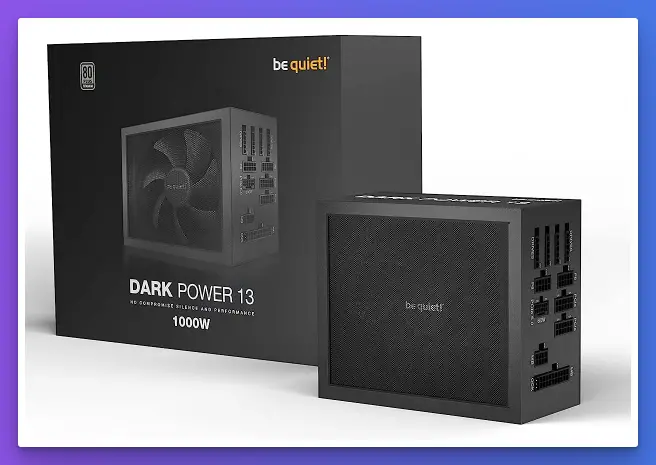
Featuring the coveted 80 Plus Titanium efficiency rating, the BN661 achieves unmatched energy efficiency, significantly reducing power wastage and keeping your energy bills in check. This ultra-high efficiency rating places it among the top-tier power supplies in the market.
The BN661 boasts advanced modular cable management, allowing you to connect only the necessary cables for a clean and clutter-free system build. This improves airflow and simplifies cable routing, resulting in a visually pleasing and well-organized setup.
Crafted with precision engineering and high-quality components, the be quiet! BN661 ensures stable and reliable power delivery, protecting your valuable components from voltage fluctuations and ensuring long-term durability.
Upgrade your system with the be quiet! BN661 power supply and experience the unparalleled power, efficiency, and reliability it offers. Elevate your computing experience to new heights, knowing you have one of the best power supplies on the market. Embrace the superior performance of the be quiet! BN661.
Pros:-
High Power Output: The be quiet! BN661 power supply offers an impressive 1000W power output, making it suitable for high-end systems and power-hungry components.
80 Plus Titanium Efficiency: With its 80 Plus Titanium efficiency rating, the BN661 achieves exceptional energy efficiency, reducing power wastage and minimizing electricity costs.
Modular Cable Management: The power supply features advanced modular cable management, allowing users to connect only the necessary cables. This improves airflow, reduces cable clutter, and simplifies cable routing for a cleaner and more organized build.
Premium Build Quality: Crafted with precision engineering and high-quality components, the BN661 ensures stable and reliable power delivery, protecting your valuable components from voltage fluctuations and enhancing long-term durability.
Silent Operation: be quiet! is known for its focus on quiet computing, and the BN661 is no exception. It features advanced fan technology and noise-reducing design elements, ensuring near-silent operation even under heavy loads.
Cons:-
Higher Price Point: The be quiet! BN661 power supply may have a higher price than lower-wattage or non-modular options, making it less accessible for budget-conscious users.
Space Requirements: The larger size of the power supply, especially with its higher power output, may require ample space within the PC case. Users should ensure compatibility with their case dimensions.
Overkill for Lower-Power Systems: The 1000W power output of the BN661 may be excessive for lower-power systems or those without power-hungry components, resulting in higher costs without utilizing their full potential.
Consider your specific power requirements, system configuration, and budget before choosing the be quiet! BN661 power supply. While it offers high power output, efficiency, and premium features, users with lower-power systems or those seeking more budget-friendly options may find other alternatives more suitable for their needs.
6. Cooler Master
When choosing the best power supply unit (PSU) brand for gaming, Cooler Master stands out as a leader in the field. With a strong reputation for quality and performance, Cooler Master has solidified its position as one of the best PSU brands for gaming.
Cooler Master PSUs are meticulously engineered to meet the demanding power requirements of gaming systems. With high-quality components and advanced technologies, they deliver reliable and stable power to ensure optimal performance during intense gaming sessions.
One of the key advantages of Cooler Master PSUs is their unwavering focus on efficiency. Many Cooler Master PSUs carry 80+ certifications, such as 80+ Bronze, 80+ Gold, or even 80+ Platinum, ensuring high energy efficiency and minimizing power wastage. This not only helps to reduce electricity costs but also contributes to environmental sustainability.
Cooler Master understands the importance of a cool and quiet gaming environment. Their PSUs are designed with advanced cooling solutions to keep temperatures in check.
Features like quiet fans, optimized fan curves, and enhanced heat dissipation mechanisms work together to maintain optimal thermal performance without sacrificing acoustics.
With a wide range of PSU options, Cooler Master caters to diverse gaming needs. Whether you’re a casual gamer or a hardcore enthusiast, Cooler Master offers PSUs with varying wattages, modular or non-modular designs, and other customizable features to suit your specific requirements.
Choose Cooler Master as your PSU brand for gaming and experience the excellence they bring to the table. Elevate your gaming experience with reliable power delivery, energy efficiency, and superior cooling. Trust in Cooler Master’s expertise to unleash the full potential of your gaming rig.
Strengths and weaknesses of Cooler Master:-
Strengths of Cooler Master:-
Diverse Product Range: Cooler Master offers various products, including power supplies, cooling solutions, cases, peripherals, and more. This extensive product lineup ensures that users can find suitable options to meet their specific needs and preferences.
Innovation and Design: Cooler Master is known for its innovation and cutting-edge design. Their products often feature unique features, advanced technologies, and stylish aesthetics that enhance the overall user experience and add visual appeal to PC builds.
Quality and Reliability: Cooler Master products exhibit high-quality construction and components, resulting in reliable and durable performance. The brand’s commitment to quality ensures that its products meet or exceed industry standards, instilling user confidence.
Cooling Solutions: Cooler Master excels in cooling solutions, offering a wide array of air and liquid cooling options. Their cooling solutions provide efficient heat dissipation, ensuring optimal thermal management and improved system performance.
Weaknesses of Cooler Master:-
Pricing: Cooler Master products, particularly their high-end offerings, can be relatively higher in price compared to some competitors. The premium features and quality may make them less accessible for budget-conscious users.
Software Integration: Some users have reported software integration and usability challenges when using Cooler Master products. Improvements in software functionality and user experience could enhance the users’ overall satisfaction.
Product Availability: The availability of Cooler Master products may vary depending on the region, limiting accessibility for certain customers. Ensuring consistent availability across different markets would enhance their reach.
Understanding the strengths and weaknesses of Cooler Master allows consumers to make informed decisions. Cooler Master’s diverse product range, innovation, quality, and cooling solutions make them popular among PC enthusiasts.
However, pricing, software integration, and product availability should be considered when evaluating their offerings. Cooler Master continues to innovate and address limitations, further solidifying its position as a reputable brand in the PC hardware industry.
Let us learn more about one of its best products:-
1. Cooler Master V1100 SFX Platinum
Introducing the Cooler Master V1100 SFX Platinum, a groundbreaking power supply that combines immense power, exceptional efficiency, and a compact form factor. Designed for enthusiasts and power users, this PSU sets new standards in performance and versatility.
With its impressive 1100W power output, the V1100 SFX Platinum provides an abundance of power to meet the demands of high-performance systems. This power supply, from gaming rigs to content creation workstations, ensures stable and reliable power delivery, even under the most demanding conditions.
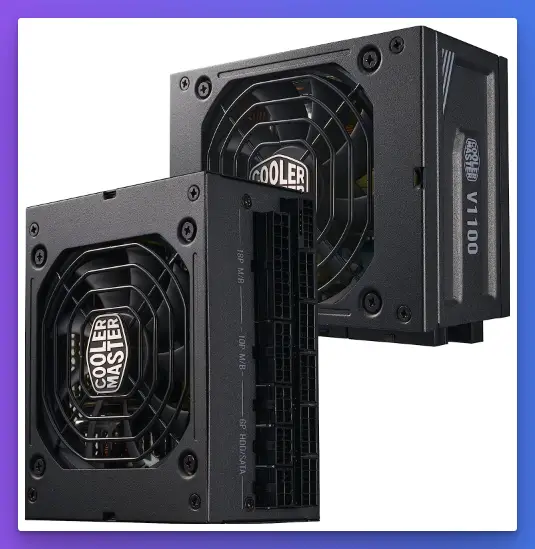
The V1100 SFX Platinum boasts an 80+ Platinum efficiency rating, guaranteeing outstanding energy efficiency and reduced power wastage. This translates into lower electricity bills and a greener computing experience without compromising performance.
Designed flexibly, the V1100 SFX Platinum features a fully modular design allowing easy cable management and customization. Connect only the necessary cables, minimizing clutter and maximizing airflow within your system.
Despite its compact SFX form factor, the V1100 SFX Platinum doesn’t compromise cooling performance. It has advanced thermal control features and maintains optimal temperatures for stable operation, ensuring reliability and longevity.
Cooler Master stands behind the V1100 SFX Platinum’s quality with a remarkable 10-year warranty, providing users peace of mind and long-term support.
Upgrade your system with the Cooler Master V1100 SFX Platinum and experience the perfect power, efficiency, and compact blend. Embrace the future of power supplies with this exceptional PSU, delivering uncompromising performance and reliability.
Pros:-
High Power Output: The Cooler Master V1100 SFX Platinum power supply delivers an impressive 1100W of power, providing ample capacity to handle high-performance systems and power-hungry components.
80+ Platinum Efficiency: With its 80+ Platinum efficiency rating, the V1100 SFX Platinum ensures excellent energy efficiency, minimizing power wastage and reducing electricity costs.
Compact Form Factor: The SFX form factor of the power supply allows for installation in smaller cases or systems where space is limited, making it suitable for compact gaming rigs or HTPC (Home Theater PC) setups.
Fully Modular Design: The V1100 SFX Platinum features a fully modular design, enabling easy cable management and customization. This allows users to connect only the necessary cables, reducing clutter and improving airflow within the system.
Advanced Thermal Control: Despite its compact size, the power supply incorporates advanced thermal control features to maintain optimal temperatures for stable and reliable operation, ensuring the longevity of the components.
Cons:-
Higher Price Point: The V1100 SFX Platinum power supply may be relatively higher than lower-wattage or non-modular options. This could be a consideration for budget-conscious users.
Limited Compatibility: The SFX form factor of the power supply may limit its compatibility with certain cases or systems designed for standard ATX power supplies. Users should ensure that their case supports the SFX form factor before purchasing.
Lower Availability: The V1100 SFX Platinum may have limited availability in certain regions or markets, making it less accessible for some users.
Consider your power requirements, system configuration, and budget before choosing the Cooler Master V1100 SFX Platinum power supply. While it offers high power output, efficiency, and a compact form factor, users with lower-power systems or those seeking more budget-friendly options may find other alternatives more suitable for their needs.
7. NZXT
Regarding finding the best power supply unit (PSU) brand, NZXT stands out as a powerhouse of innovation and performance. With its relentless commitment to quality and cutting-edge design, NZXT has established itself as one of the best PSU brands in the market.
NZXT PSUs embody a perfect fusion of form and function. These power supplies are built with meticulous attention to detail, utilizing high-quality components and advanced technologies to deliver reliable and efficient power to your system.
One of the standout features of NZXT PSUs is their unrivaled design aesthetic. NZXT believes power supplies should deliver exceptional performance and complement your PC build’s aesthetics.
Their PSUs feature sleek, modern designs with customizable RGB lighting options, allowing you to personalize your system and create a visually stunning setup.
NZXT also places great emphasis on reliability and efficiency. Their PSUs are designed with robust circuitry and comprehensive protection features to ensure stable power delivery and safeguard your valuable components. Additionally, NZXT PSUs often carry 80+ certifications, such as 80+ Gold or 80+ Platinum, signifying excellent energy efficiency and reduced power wastage.
With a wide range of wattages and modular/non-modular options, NZXT caters to various power requirements and system configurations. Whether you are a casual gamer, a content creator, or an enthusiast, NZXT has a PSU that suits your specific needs.
Choose NZXT as your go-to PSU brand and experience the perfect blend of innovation, performance, and style. Elevate your PC build with reliable power delivery, stunning aesthetics, and peace of mind from one of the best PSU brands in the industry.
Strengths and weaknesses of NZXT:-
Strengths of NZXT:-
Innovative Design Aesthetics: NZXT is celebrated for its innovative and sleek design aesthetics. Their products, including cases, cooling solutions, and peripherals, showcase modern and minimalist designs that elevate the visual appeal of PC builds.
Smart Integration and Control: NZXT embraces smart integration and control through its CAM software. This powerful software allows users to monitor and control various aspects of their system, including lighting, fan speeds, and performance, providing a seamless and intuitive user experience.
Build Quality and Durability: NZXT products exhibit excellent build quality, utilizing premium materials and meticulous craftsmanship. This attention to detail ensures that their products are durable and capable of withstanding the demands of PC enthusiasts and gamers.
Community Engagement: NZXT fosters a strong and engaged community through its online forums, social media presence, and active participation in the PC gaming and modding community. This fosters a sense of community and encourages user feedback and collaboration.
Weaknesses of NZXT:-
Pricing: NZXT products may be positioned in the higher price range, particularly their higher-end offerings. The premium design and features may make them less accessible for budget-conscious consumers.
Product Availability: The availability of NZXT products can vary depending on the region, which may limit accessibility for certain customers. Ensuring consistent availability across different markets would enhance their reach.
Customer Support: While NZXT generally provides good customer support, some users have reported mixed experiences. Improvements in responsiveness and addressing customer concerns promptly would contribute to an improved overall customer experience.
Understanding the strengths and weaknesses of NZXT allows consumers to make informed decisions. NZXT’s innovative design aesthetics, smart integration, build quality, and community engagement make them popular among PC enthusiasts.
However, pricing, product availability, and customer support should be considered when evaluating their offerings. NZXT continues to innovate and address limitations, further solidifying its position as a reputable brand in the PC hardware industry.
Let us learn more about one of its best products:-
1. NZXT E850
The NZXT E850 is an exceptional gaming power supply that redefines power and performance standards. Designed for gamers and PC enthusiasts, this PSU delivers uncompromising power, silent operation, and cutting-edge features to enhance your gaming experience.
With its 850-watt power output, the NZXT E850 provides ample power to support high-performance gaming systems, ensuring stable and reliable power delivery even during intense gaming sessions or resource-intensive tasks.

The E850 features a fully modular design, allowing for easy cable management and customization. Connect only the necessary cables to reduce clutter, improve airflow, and build a clean and organized system.
NZXT understands the importance of silent operation for an immersive gaming environment. The E850 incorporates advanced fan control and noise reduction technologies, producing whisper-quiet performance. Enjoy your gaming sessions without distractions from fan noise.
Equipped with 80 Plus Gold certification, the E850 guarantees excellent energy efficiency, reducing power wastage and lowering electricity bills while minimizing environmental impact.
This PSU takes innovation further with its digital voltage and temperature monitoring. Real-time monitoring of voltage levels and temperature ensures optimal performance and system stability, allowing you to keep track of critical metrics at all times.
NZXT backs the E850 with a 10-year warranty, showcasing its commitment to quality and reliability. Game with confidence, knowing that your PSU is protected for the long term.
Upgrade your gaming rig with the NZXT E850 and experience its power, performance, and peace of mind. Unleash your gaming potential with this exceptional PSU that benchmarks quality and innovation.
Pros:-
High Power Output: The NZXT E850 power supply offers an impressive 850-watt power output, providing ample capacity to support high-performance gaming systems and power-hungry components.
Fully Modular Design: The E850 is fully modular, allowing for easy cable management and customization. This not only improves airflow but also simplifies the installation process.
Silent Operation: NZXT prioritizes silent operation in their power supplies, and the E850 is no exception. It incorporates advanced fan control and noise reduction technologies, ensuring quiet performance even during intense gaming sessions.
Energy Efficiency: The E850 is 80 Plus Gold certified, guaranteeing high energy efficiency. This helps reduce power wastage and lowers electricity bills, making it an environmentally friendly choice.
Digital Monitoring: The E850 offers digital voltage and temperature monitoring, allowing users to monitor critical metrics in real time. This feature enables users to monitor their system’s performance and make necessary adjustments.
Cons:-
Higher Price: The NZXT E850 power supply may be higher than lower-wattage or non-modular options. This could be a consideration for budget-conscious users.
Limited Availability: Depending on the region, the availability of the NZXT E850 power supply may vary, making it less accessible for some users.
Size Requirements: The E850 may have larger dimensions due to its higher power output. Users should ensure that their case can accommodate its size before purchasing.
Digital Monitoring Complexity: While the digital monitoring feature is useful, it may have a learning curve for users unfamiliar with monitoring software or adjusting settings.
Consider your specific power requirements, system configuration, and budget before choosing the NZXT E850 power supply. While it offers high power output, modular design, silent operation, and digital monitoring, users with lower-power systems or those seeking more budget-friendly options may find other alternatives more suitable for their needs.
Comparison of PSU Brands
When choosing the right power supply unit (PSU) for your computer, the market is brimming with various options from various brands. This article compares PSU brands to help you decide based on your requirements.
1. Corsair:- Corsair, a well-established brand in the PC components industry, offers a wide range of PSUs catering to different power needs. Their products are known for their reliability, efficiency, and robust build quality. The Corsair PSU lineup includes models such as the RMx Series, HXi Series, and AX Series, which provide excellent performance and stable power delivery.
2. EVGA:- EVGA is another prominent player in the PSU market, renowned for its innovative designs and cutting-edge technologies. Their SuperNOVA series, including models like the G3, P2, and T2, has garnered praise for its exceptional efficiency, modular cabling options, and reliable performance under heavy loads. EVGA’s commitment to customer satisfaction is reflected in its generous warranty policies and responsive support.
3. Seasonic:- Seasonic, synonymous with high-quality PSUs, has been delivering top-notch power solutions for decades. Their PSUs are known for their excellent voltage regulation, low noise levels, and high efficiency. The Focus Plus, Prime, and X Series are some of Seasonic’s noteworthy offerings, catering to both mainstream and enthusiast users.
4. Thermaltake:- Thermaltake has earned a prominent spot in the market with a diverse range of PSUs to suit different budgets and requirements. Their Toughpower, Smart, and Toughpower Grand series offer reliable performance, modular designs, and good value for money. Thermaltake’s commitment to sustainability is evident through its eco-friendly features and compliance with energy efficiency standards.
5. Antec:- Antec is a trusted brand renowned for its high-quality PSUs catering to gaming enthusiasts and professionals. Their High Current Gamer, EarthWatts, and Signature series balance performance, efficiency, and affordability. Antec’s commitment to reliability is further emphasized by its rigorous testing processes and durable components.
6. Be Quiet!:- Be Quiet! has gained recognition for its focus on silent operation and premium build quality. Their PSUs, such as the Dark Power Pro, Straight Power, and Pure Power, incorporate advanced technologies to minimize noise levels while delivering stable and efficient power to your system. These PSUs are particularly suitable for users who prioritize a quiet computing experience.
7. Cooler Master:- Cooler Master, a well-known brand in the PC industry, offers a diverse range of PSUs that cater to different power requirements. Their MasterWatt, MWE Gold, and V series provide reliable performance, modular designs, and competitive pricing. Cooler Master’s commitment to quality is evident through its extensive testing procedures and attention to detail.
In conclusion, when comparing PSU brands, it is essential to consider factors such as reliability, efficiency, performance, and customer support. Each brand mentioned in this article has its strengths and caters to different user needs.
By understanding your requirements and conducting thorough research, you can make an informed decision and choose the PSU brand that best suits your computing needs.
Remember to consider the power requirements of your system, the brand’s reputation, and any specific features or technologies that align with your preferences. Investing in a high-quality PSU from a reputable brand ensures stable power delivery, longevity, and peace of mind for your computer system.
| Brand | Average User Rating (Out of 5) |
|---|---|
| Corsair | 4.8 |
| EVGA | 4.7 |
| Seasonic | 4.9 |
| Thermaltake | 4.5 |
| Antec | 4.6 |
| Be Quiet! | 4.8 |
| Cooler Master | 4.6 |
Best 850W PSU: Powering Your System with Optimal Performance
Choosing the best 850W PSU (Power Supply Unit) is critical for PC enthusiasts and power-hungry users. A high-quality PSU ensures stable and efficient power delivery and provides headroom for future upgrades.
Let’s explore some exceptional 850W PSUs available in the market, offering reliability, efficiency, and robust performance.
1. Corsair RM850x
The Corsair RM850x stands out as one of the top contenders in the 850W PSU category. With its 80 Plus Gold certification, this PSU delivers exceptional energy efficiency, reducing power wastage and operating costs.
Equipped with high-quality Japanese capacitors and a fully modular design, the RM850x offers superb reliability and ease of cable management. Its low noise operation and advanced cooling features make it an excellent choice for users seeking a silent computing experience.
2. EVGA SuperNOVA 850 G3
EVGA’s SuperNOVA 850 G3 is another formidable option for those searching for the best 850W PSU. This 80 Plus Gold-certified unit boasts impressive efficiency and stability thanks to its superior build quality and top-grade components.
The G3 series PSU is renowned for its compact size, making it ideal for smaller PC cases without compromising performance. EVGA’s exceptional customer support and generous warranty further solidify the SuperNOVA 850 G3’s reputation as a reliable choice.
3. Seasonic FOCUS GX-850
Seasonic’s FOCUS GX-850 power supply combines power and efficiency to meet the demands of high-performance systems. With its 80 Plus Gold certification and a fully modular design, this PSU achieves remarkable energy efficiency and cable management convenience.
The FOCUS GX-850 features a hybrid silent fan control, ensuring optimized cooling while minimizing noise levels. Seasonic’s renowned build quality and reliability make the FOCUS GX-850 popular among enthusiasts and professionals.
4. be quiet! Straight Power 11 850W
For users seeking a whisper-quiet PSU without compromising on performance, be quiet! Straight Power 11 850W proves to be an excellent option. This 80 Plus Platinum certified PSU delivers exceptional power efficiency and stability, ensuring smooth and reliable operation.
Equipped with be quiet!’s Silent Wings 3 fan, the Straight Power 11 850W offers efficient cooling with virtually silent operation. Its modular cable management system enhances airflow and simplifies installation, making it a preferred choice among noise-conscious users.
5. Thermaltake Toughpower Grand RGB 850W
The Thermaltake Toughpower Grand RGB 850W PSU combines robust performance with stunning aesthetics. This 80 Plus Gold certified power supply boasts a fully modular design and delivers reliable power to high-end systems.
Its customizable RGB lighting sets it apart, allowing users to match their system’s color scheme and add visual flair to their build. The Toughpower Grand RGB 850W features an ultra-quiet fan and advanced voltage regulation for optimal performance and quiet operation.
In conclusion, when searching for the best 850W PSU, it is crucial to consider factors such as efficiency, reliability, noise levels, and additional features. Each PSU mentioned in this article offers exceptional performance and caters to different user preferences.
Whether you prioritize energy efficiency, silent operation, or premium aesthetics, there is a perfect choice. Invest in a high-quality 850W PSU to stabilize your system and ensure smooth performance for your demanding computing needs.
Best 750W PSU: Ensuring Reliable Power for Your High-Performance System
Selecting the best 750W PSU (Power Supply Unit) is crucial for PC enthusiasts and gamers seeking optimal power delivery and stability. A high-quality PSU provides sufficient wattage for demanding components and ensures efficiency and longevity.
Let’s explore some exceptional 750W PSUs available in the market, offering reliability, performance, and energy efficiency.
1. Corsair RM750x
The Corsair RM750x stands out as one of the top contenders in the 750W PSU category. Featuring an 80 Plus Gold certification, this PSU delivers impressive energy efficiency and reduced power wastage.
Equipped with premium Japanese capacitors and a fully modular design, the RM750x offers reliable and efficient power delivery. Its low-noise operation and advanced cooling features make it an excellent choice for users seeking a quiet computing experience without compromising performance.
2. EVGA SuperNOVA 750 G5
The EVGA SuperNOVA 750 G5 is another notable option for those searching for the best 750W PSU. With its 80 Plus Gold certification and exceptional build quality, this PSU ensures stable power delivery and high efficiency.
The G5 series PSU incorporates top-grade components and a compact design, making it suitable for various PC configurations. EVGA’s excellent customer support and extensive warranty coverage further solidify the SuperNOVA 750 G5’s reputation as a reliable choice.
3. Seasonic FOCUS GX-750
Seasonic’s FOCUS GX-750 power supply is renowned for its outstanding performance and reliability. With an 80 Plus Gold certification and a fully modular design, this PSU offers excellent power efficiency and cable management convenience.
The FOCUS GX-750 incorporates high-quality components, ensuring stable power delivery and durability. It features a hybrid silent fan control for optimized cooling and minimal noise levels. Seasonic’s commitment to quality and reliability makes the FOCUS GX-750 popular among PC enthusiasts.
4. be quiet! Straight Power 11 750W
The be quiet! Straight Power 11 750W PSU combines exceptional performance with silent operation. With an 80 Plus Platinum certification, this power supply achieves remarkable energy efficiency and stability.
The Straight Power 11 750W incorporates be quiet!’s Silent Wings 3 fan for efficient cooling with virtually silent operation. Its fully modular design and high-quality components make installation and cable management a breeze. This PSU is ideal for users prioritizing performance and a noise-free computing experience.
5. Thermaltake Toughpower GF1 750W
The Thermaltake Toughpower GF1 750W PSU offers reliable and efficient power delivery for high-performance systems. With an 80 Plus Gold certification and a compact design, this power supply ensures energy efficiency and compatibility with various PC builds.
The Toughpower GF1 750W incorporates a quiet hydraulic bearing fan and advanced voltage regulation for optimal performance and quiet operation. Its fully modular design and durable components make it a reliable choice for demanding users.
In conclusion, selecting the best 750W PSU requires careful consideration of factors such as efficiency, reliability, noise levels, and additional features. Each PSU mentioned in this article provides exceptional performance and caters to different user preferences.
Whether you prioritize energy efficiency, silent operation, or ease of cable management, there is a perfect choice. Invest in a high-quality 750W PSU to ensure reliable power delivery and the smooth operation of your high-performance system.
Exploring the Best SFX Power Supply Units
A reliable SFX power supply is indispensable when powering compact and high-performance systems. These pint-sized powerhouses deliver efficiency and stability to small form factor (SFF) builds and mini-ITX systems, ensuring optimal performance without compromising space.
Discover some of the best SFX power supply units and their exceptional capabilities.
1. Corsair SF750 Platinum
With an impressive 750-watt capacity, the Corsair SF750 Platinum ranks among the top choices for SFF enthusiasts. Its 80 Plus Platinum certification guarantees remarkable energy efficiency, reducing power wastage and excess heat. This power supply boasts fully modular cabling, enabling easy cable management in confined spaces.
2. SilverStone SX800-LTI
SilverStone’s SX800-LTI brings 800 watts of power in an SFX-L form factor, making it compatible with SFX and ATX cases. It achieves 80 Plus Titanium certification, exemplifying unparalleled efficiency and ensuring stable power delivery for high-performance components.
3. Seasonic SGX-650
The Seasonic SGX-650 balances performance and affordability, delivering 650 watts of power. Its 80 Plus Gold certification denotes excellent efficiency, while the quiet fan ensures silent operation even under heavy loads.
4. EVGA SuperNOVA 650 GM
EVGA’s SuperNOVA 650 GM packs a punch with 650 watts of power and an 80 Plus Gold rating. This compact SFX power supply offers semi-modular cabling, simplifying cable management in small builds.
5. be quiet! SFX L Power 600W
Designed with premium quality in mind, the be quiet! SFX L Power 600W offers 600 watts of reliable power. Its 80 Plus Gold efficiency rating ensures optimal energy conversion, while the quiet fan design checks noise levels.
6. FSP Dagger Pro 650W
The FSP Dagger Pro 650W showcases a sleek design and delivers 650 watts of power. Its 80 Plus Gold certification guarantees energy efficiency, and the fully modular design enhances cable management.
In conclusion, the best SFX power supply units offer a harmonious blend of compact size, high power output, and energy efficiency. Whether you’re building a mini-ITX gaming rig or a powerful workstation, these top-notch SFX power supplies ensure that your small form factor system is primed for peak performance.
Embrace the power and efficiency of these units, and watch your SFF build thrive with unparalleled reliability and stability.
Can a Power Supply Be Too Strong?
Whether a power supply can be too strong is a subject of interest for PC enthusiasts and builders alike. Theoretically, having a power supply with a higher wattage than the system requires might seem advantageous, ensuring ample power for future upgrades and preventing strain on the power supply during peak loads. However, there are some considerations to keep in mind.
Having a power supply that is too strong can lead to inefficiency, as power supplies operate most efficiently when they are loaded within a specific range of their capacity.
A significantly overpowered power supply might operate below its optimal efficiency levels during regular usage, resulting in increased power consumption and higher electricity bills.
Furthermore, power supplies are designed to regulate voltage and current output based on the system’s demands. If the power supply’s capacity far exceeds the system’s needs, it might not operate as efficiently at lower loads, leading to voltage regulation issues and potential instability.
Moreover, an excessively powerful power supply might occupy more space, generate more heat, and have a higher cost, impacting the overall build’s size, cooling, and budget considerations.
In conclusion, while it is generally safe to have a power supply with a slightly higher wattage than the system’s requirements, going too strong can lead to inefficiency, increased costs, and potential stability issues.
It is essential to balance having enough power to support current and future upgrades while maintaining optimal efficiency and performance. Consulting with experts or using online power supply calculators can help determine the appropriate wattage for your specific system requirements, ensuring an optimal and stable computing experience.
📗FAQ’s
Which brand is best for PSU?
The market offers several reputable PSU brands, including Seasonic, Corsair, and EVGA. The best brand for a PSU depends on individual preferences, specific requirements, and budget considerations.
Is Seasonic still the best?
Seasonic continues to be highly regarded for its outstanding build quality, reliability, and efficiency. Their PSUs are often considered among the best in the industry, making Seasonic a top choice for many enthusiasts and professionals.
What type of PSU is best for gaming?
When it comes to gaming, a high-quality and reliable PSU is essential. Look for models with ample wattage, efficient power delivery, and dedicated PCIe connectors to support power-hungry components like graphics cards.
Is Thermaltake a Good Brand?
When delving into computer hardware and peripherals, enthusiasts, and consumers find themselves confronted with a sea of choices, each promising unrivaled performance and quality.
Among these options stands Thermaltake, a company that has garnered both acclaim and skepticism within the tech community.
Thermaltake, a pioneer in cooling solutions and power supplies, has steadily expanded its product range. The brand has earned a reputation for innovation, frequently pushing the boundaries of design and functionality. Their commitment to sustainability and the implementation of cutting-edge materials further solidifies their stance in the industry.
One of Thermaltake’s standout features is its dedication to user-centric design, ensuring that its products cater to the needs of discerning consumers. Thermaltake seeks to deliver reliability and superior performance across the board, from casual gamers to hardcore overclockers.
Nevertheless, like any brand, Thermaltake is not without its detractors. Some critics point to occasional quality control issues, though it’s essential to acknowledge that even the most reputable brands may encounter such challenges.
In conclusion, Thermaltake has undoubtedly established itself as a force to be reckoned with in the computer hardware industry. Their commitment to innovation, user-focused approach, and expanding product range make them a compelling choice for tech enthusiasts seeking top-notch components.
Conducting thorough research and considering individual needs and preferences will help determine if Thermaltake meets one’s requirements.
PSU brands that use Japanese capacitors?
Certain brands have distinguished themselves among the plethora of PSU manufacturers by consistently incorporating Japanese capacitors into their designs.
These brands understand that the capacitors’ enhanced heat resistance and lower failure rates contribute to their PSUs’ overall reliability and performance.
Seasonic is one such brand, revered for its commitment to quality. Their PSUs, often equipped with Japanese capacitors, are a testament to their dedication to delivering robust and reliable power solutions.
Another noteworthy brand is Corsair. Their higher-end PSU models, such as the AX and HX series, frequently employ Japanese capacitors, ensuring optimal performance and longevity.
EVGA, too, joins this elite group. Their SuperNOVA series, particularly, is known for utilizing Japanese capacitors, offering superior performance and durability.
In conclusion, PSU brands that use Japanese capacitors—like Seasonic, Corsair, and EVGA—demonstrate a commitment to quality and reliability.
By choosing these brands, consumers can ensure they’re investing in a PSU that delivers consistent power, longevity, and superior performance.
Does it matter what brand of PSU I get?
While the brand is important, it’s crucial to consider factors such as build quality, reliability, efficiency, and customer support. Reputable brands like Seasonic, Corsair, and EVGA generally offer reliable options.
What is the most reliable PSU?
The most reliable PSU models are those that undergo rigorous testing, use high-quality components, and have a solid track record for performance and durability. Seasonic and Corsair are renowned for their reliability.
Are Seasonic PSUs better than Corsair?
Both Seasonic and Corsair offer excellent PSUs, each with its strengths. Seasonic is highly regarded for its build quality and efficiency, while Corsair is known for its broad range of options and excellent customer support.
Is NZXT PSU Seasonic?
Several different OEMs, including Seasonic, manufacture NZXT PSUs. It’s essential to check the specific model’s manufacturer and review its specifications to determine the PSU’s quality and performance.
Does Corsair use Seasonic?
Corsair works with multiple OEMs for its PSU lineup, and Seasonic is one of them. Corsair also collaborates with other reputable manufacturers to provide consumers a wide range of PSU options.
Does overkill PSU matter?
An overkill PSU, with a significantly higher wattage than your system requires, doesn’t harm your components. However, it may result in higher upfront costs and lower efficiency since PSUs typically operate most efficiently at around 50-70% load.
Is a heavier PSU better?
The weight of a PSU doesn’t necessarily indicate its quality or performance. The weight can vary depending on the components and the PSU’s design. When evaluating a PSU, Focus on efficiency, reliability, and certifications.
What is the recommended PSU for RTX?
The recommended PSU wattage for an RTX graphics card depends on the specific model. Generally, a high-quality 650W to 750W PSU should suffice for most mid-range to high-end RTX cards.
Is it OK to use a cheap PSU?
Using a cheap PSU comes with risks as they often lack quality control and may have inferior components. It’s crucial to prioritize a reliable and well-built PSU from reputable brands to ensure the safety and longevity of your system.
What to know before buying a PSU?
Before purchasing a PSU, consider factors such as wattage requirements, efficiency ratings, modular or non-modular design, brand reputation, customer reviews, and warranty terms. Ensuring compatibility with your system’s components is essential.
How do you know if a PSU is good?
A good PSU typically features high-efficiency ratings (such as 80+ Gold or Platinum), reliable performance, ample wattage for your system’s needs, stable voltage regulation, and adequate protection against overvoltage, under voltage, and short circuits.
What is the life expectancy of a PSU?
The average life expectancy of a PSU is around 5 to 10 years. However, this can vary depending on factors like usage, workload, environmental conditions, and the quality of the PSU itself.
What is the most common PSU?
The most common PSU form factor is the ATX (Advanced Technology Extended) form factor, widely used in desktop computers. It offers a standardized size and mounting layout that accommodates most PC cases.
How long should a good PSU last?
Depending on usage and other factors, a good PSU can last anywhere from 7 to 12 years. Regular maintenance, such as cleaning dust buildup and ensuring proper airflow, can help prolong its lifespan.
Can you overdo a PSU?
Having a higher wattage PSU is generally safe than what your system requires. However, excessively high-wattage PSUs may operate less efficiently at lower loads, resulting in higher upfront costs.
Does a 1000W PSU use 1000W all the time?
A PSU only draws the power the system requires, not the maximum wattage it can provide. Thus, a 1000W PSU won’t consume 1000W continuously if the system’s demand is lower.
How strong should your PSU be?
Your PSU’s strength (wattage) should be sufficient to meet the power requirements of your system components. It’s recommended to have some headroom for potential future upgrades or expansions.
What brands use Seasonic?
Several brands utilize Seasonic as an OEM, including Corsair, NZXT, XFX, and some models from Antec, ASUS, and Cooler Master. This highlights the reputation and trust in Seasonic’s manufacturing capabilities.
Why are Corsair PSUs so expensive?
Corsair PSUs often come with premium features, high-efficiency ratings, and excellent build quality, contributing to their higher price points. Corsair’s brand recognition and reputation also influence pricing.
Why is Corsair so good?
Corsair has established itself as a leading brand in the PC hardware industry by consistently delivering high-quality products, excellent customer support, and innovative designs. Their dedication to customer satisfaction sets them apart.
What is the failure rate of Seasonic PSUs?
Seasonic PSUs are known for their low failure rates, thanks to their meticulous manufacturing processes, stringent quality control, and use of high-quality components. The specific failure rate may vary depending on the model and usage conditions.
Who makes Seasonic?
Seasonic is an original equipment manufacturer (OEM) that designs and manufactures its PSUs. They are recognized for their exceptional build quality, performance, and reliability.
What PSU is best for water cooling?
A high-quality PSU with ample wattage to support the components and additional cooling systems is recommended when water cooling your system. Look for PSUs from reputable brands like Corsair, EVGA, or Seasonic.
Is Corsair or EVGA better for power supply?
Both Corsair and EVGA are reputable brands known for their high-quality PSUs. The choice between the two depends on specific model features, wattage requirements, personal preference, and budget considerations.
What is an alternative to Corsair?
If you’re looking for alternatives to Corsair PSUs, other reputable brands include EVGA, Seasonic, be quiet!, Cooler Master, and Thermaltake. Each brand offers a wide range of options to suit different needs.
Is Seasonic a good PSU company?
Seasonic is a top PSU company known for its exceptional build quality, efficiency, and reliability. Their dedication to innovation and customer satisfaction has earned them a strong reputation in the industry.
Does more RAM use more PSU?
RAM modules consume minimal power compared to other components in a system. Therefore, the impact of additional RAM on PSU power consumption is negligible and doesn’t typically require a PSU upgrade.
Is an 850W PSU overkill?
An 850W PSU is considered overkill for most average gaming systems. However, it provides headroom for high-end systems with power-hungry components or if you plan to overclock or make future upgrades.
Will a better PSU increase FPS?
Upgrading to a better PSU will not directly increase games’ FPS (frames per second). The performance of the CPU, GPU, and RAM primarily influences FPS. A reliable PSU ensures stable power delivery to support these components.
How often should you replace PSU?
PSU replacement intervals vary depending on usage, environmental conditions, and system requirements. On average, it is recommended to consider a replacement after 7 to 10 years or if signs of degradation and instability appear.
What power supply do I need for RTX 3060?
For an RTX 3060, a high-quality 650W to 750W PSU should be sufficient, considering the power requirements of the graphics card, CPU, and other system components.
How do I know if my PSU is not enough?
Signs that your PSU might be insufficient include random system shutdowns, instability, or failure to power up certain components. Monitoring power draw and online PSU calculators can help assess if your current PSU meets the system’s requirements.
What PSU do I need for 3070 vs 3080?
For an RTX 3070, a high-quality 650W to 750W PSU is recommended. For an RTX 3080, it is recommended to have a high-quality 750W to 850W PSU to ensure stable and reliable power delivery.
Is 750W enough for RTX 3080?
A 750W PSU is generally sufficient for an RTX 3080, especially if it is a high-quality unit with ample power on the 12V rail. However, if you plan to overclock or have a power-hungry system, an 850W PSU may provide more headroom.
What PSU is 3080 rated for?
NVIDIA recommends using a PSU with a minimum power rating of 750W for the RTX 3080. However, higher-rated PSUs, such as 850W, are recommended for systems with additional power-hungry components or overclocking.
Is a 1000W PSU expensive to run?
The running cost of a 1000W PSU depends on various factors such as electricity rates, system load, and efficiency rating. While higher-wattage PSUs may consume more power, the cost difference is typically minimal in day-to-day usage.
How long does a cheap PSU last?
The lifespan of a cheap PSU can vary significantly. While some may fail prematurely, others may last a few years. Investing in a high-quality PSU from reputable brands ensures better longevity and reliability.
Does a 1000W PSU cost more to run?
A 1000W PSU may have a slightly higher idle power consumption than lower-wattage PSUs. However, the difference in running costs is usually minimal unless the system is under heavy load for extended periods.
Does PSU need cleaning?
Yes, PSUs can accumulate dust over time, which can hinder airflow and lead to overheating. Regular cleaning, especially of the PSU fan and vents, helps maintain optimal performance and prolongs its lifespan.
What to do before installing a new PSU?
Before installing a new PSU, ensure you have the correct wattage for your system, check the physical dimensions to ensure compatibility with your case, backup important data, and follow proper safety procedures, including disconnecting power and grounding yourself.
How much should a PSU cost?
PSU prices vary depending on wattage, efficiency ratings, and brand. Generally, for a reliable and efficient PSU, budget around $70 to $150 for mainstream systems, while higher-end or specialized PSUs can range from $150 to $300 or more.
Conclusion
Choosing the right PSU brand for your computer setup is an investment in your system’s long-term performance and reliability. Although it can be tempting to opt for cheaper alternatives, remember that a high-quality PSU from a reputable brand can safeguard your costly components and ensure a smoother and more efficient operation.
Through exploring the best PSU brands in this article, we’ve shed light on what makes each brand stand out, providing you with the essential knowledge to make an informed decision tailored to your specific needs.
In computing, it’s critical to remember that every component plays a significant role, and the PSU is no exception. So, consider your options carefully, ensure that your chosen PSU meets your system’s requirements, and game or work with the confidence that your PC has the reliable power it needs.
If you found this article helpful, feel free to share it with others who might also benefit from this knowledge. And remember, choosing the best PSU brand is not an expense but an investment in your PC’s future performance and longevity.

























